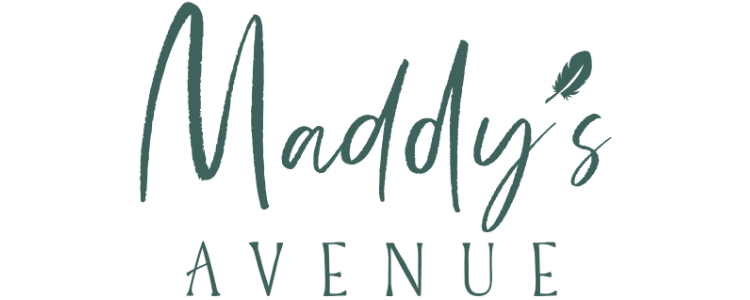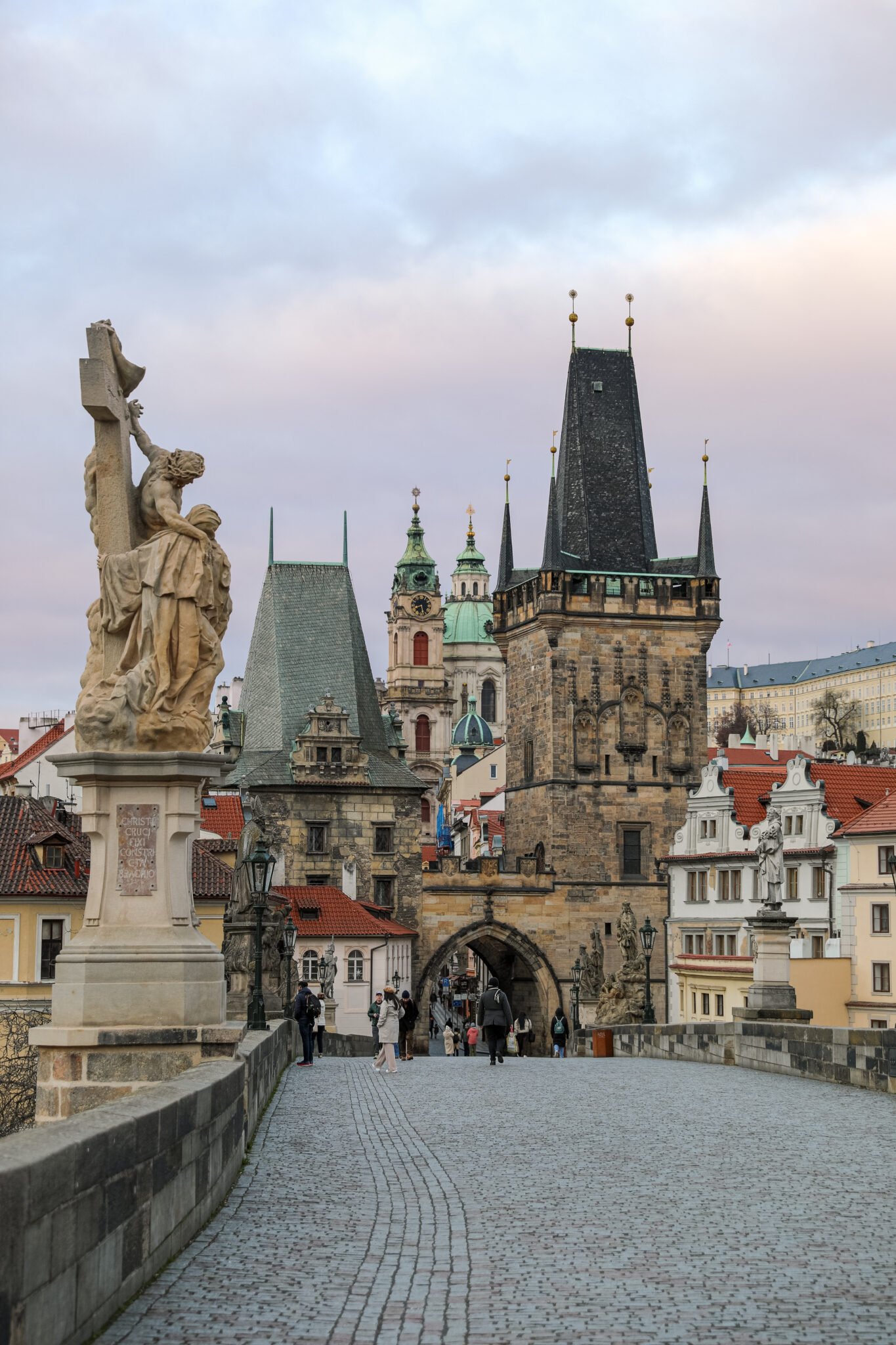Ultimate Guide to Kanazawa: Best Things to Do & See
Disclosure: This post may contain affiliate links; more info here.
Planning a trip to Kanazawa, Japan (A.K.A. “Little Kyoto”)? As Kanazawa’s biggest fan, I’ll say – that’s a great idea.
Tucked between the Sea of Japan and the Japanese Alps, this cultural and culinary hub in the Hokuriku region has everything that makes Japan so special. Like perfectly preserved geisha districts, tranquil gardens, and the freshest seafood you’ll ever taste.
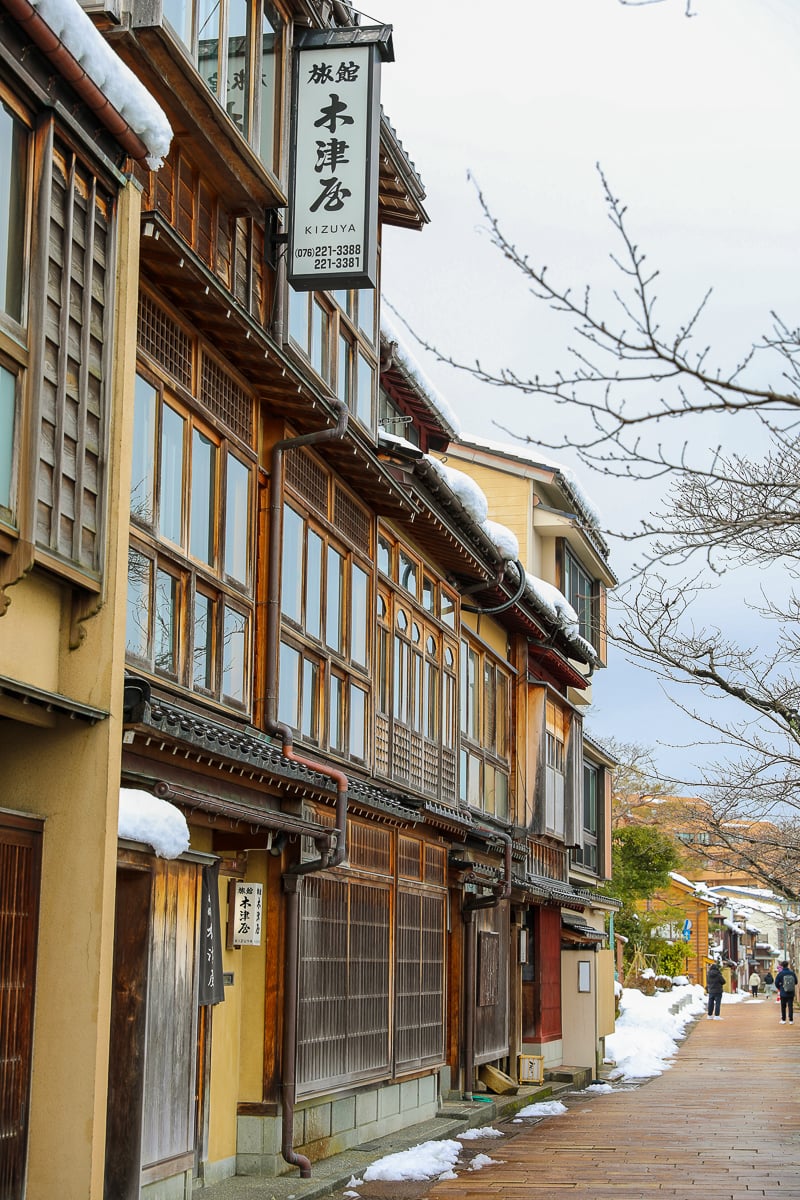
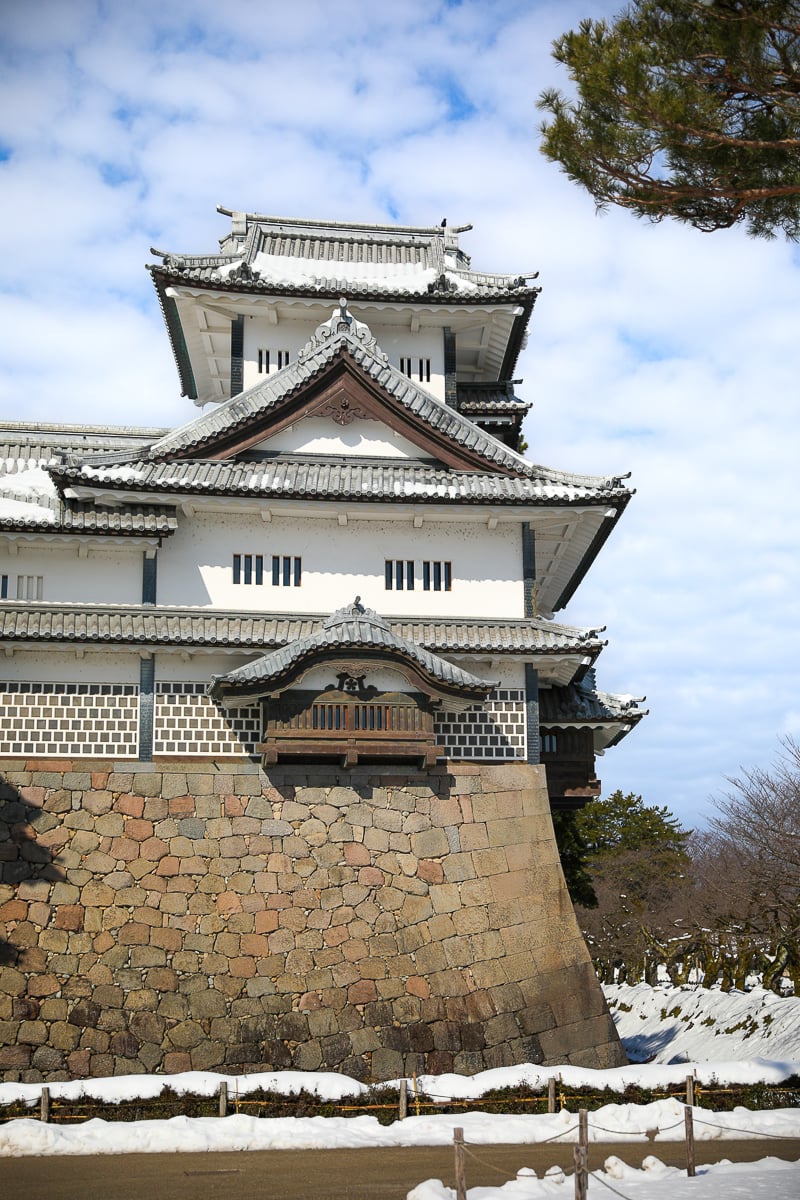
All with a fraction of the crowds and chaos of Kyoto, Osaka, or Tokyo – each just two to three hours away by train.
I recently spent a week in Kanazawa and left with a big claim: this is Japan’s most underrated destination. So go soon – before everyone else catches on.
You’ll stroll the grand Kanazawa Castle and the “perfect” Kenrokuen Garden. Step back in time in the Edo-period samurai district and tour the booby-trapped Ninja Temple. Sip matcha in centuries-old teahouses. And browse intricate folk art and gold leaf crafts (Kanazawa is called the “City of Gold” for a reason).
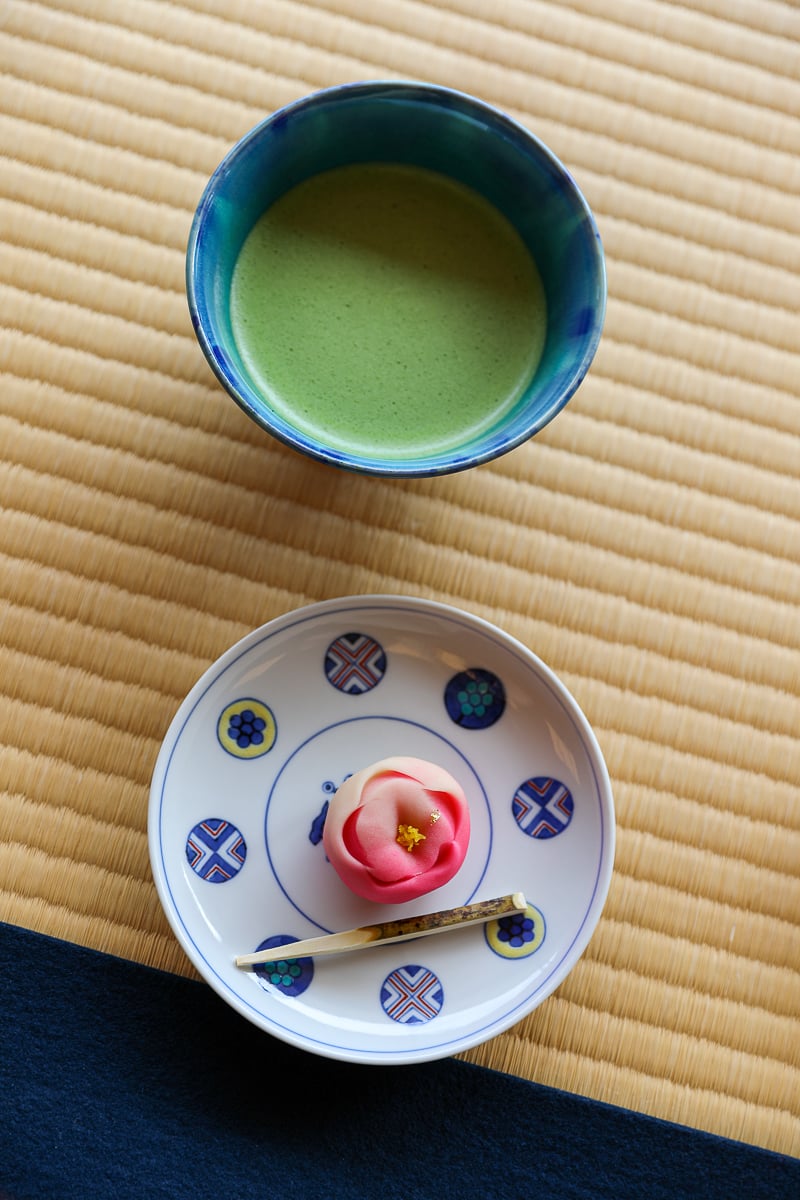
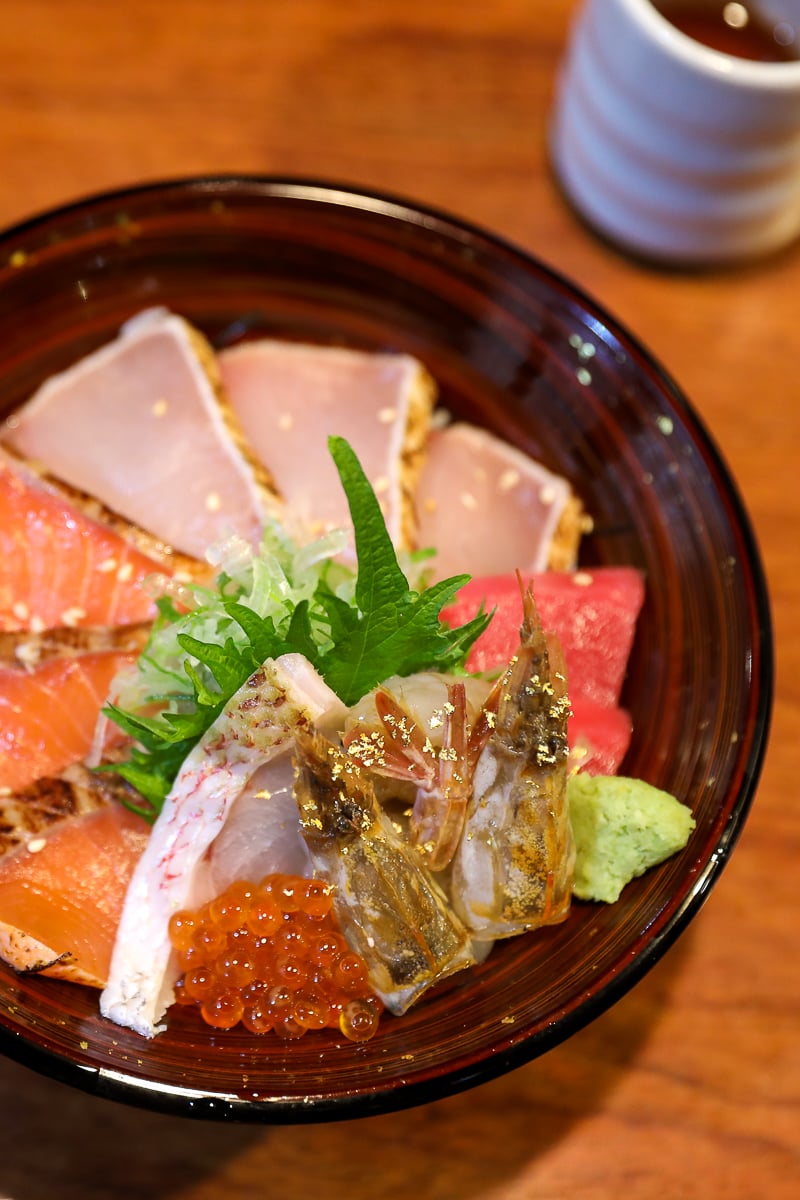
And then there’s the best restaurants in Kanazawa. From sushi bars and izakayas to Omicho Market, every bite celebrates the bounty of Ishikawa Prefecture. Snow crab, sashimi bowls, Kanazawa-style curry, and Noto wagyu beef await you – often with a sprinkle of edible gold. I’m drooling now… Are you?
My Kanazawa travel guide covers everything you need to plan your trip – the best things to do in Kanazawa, where to stay, what to eat, and all the must-know travel tips. Ready to experience the magic of Kanazawa?
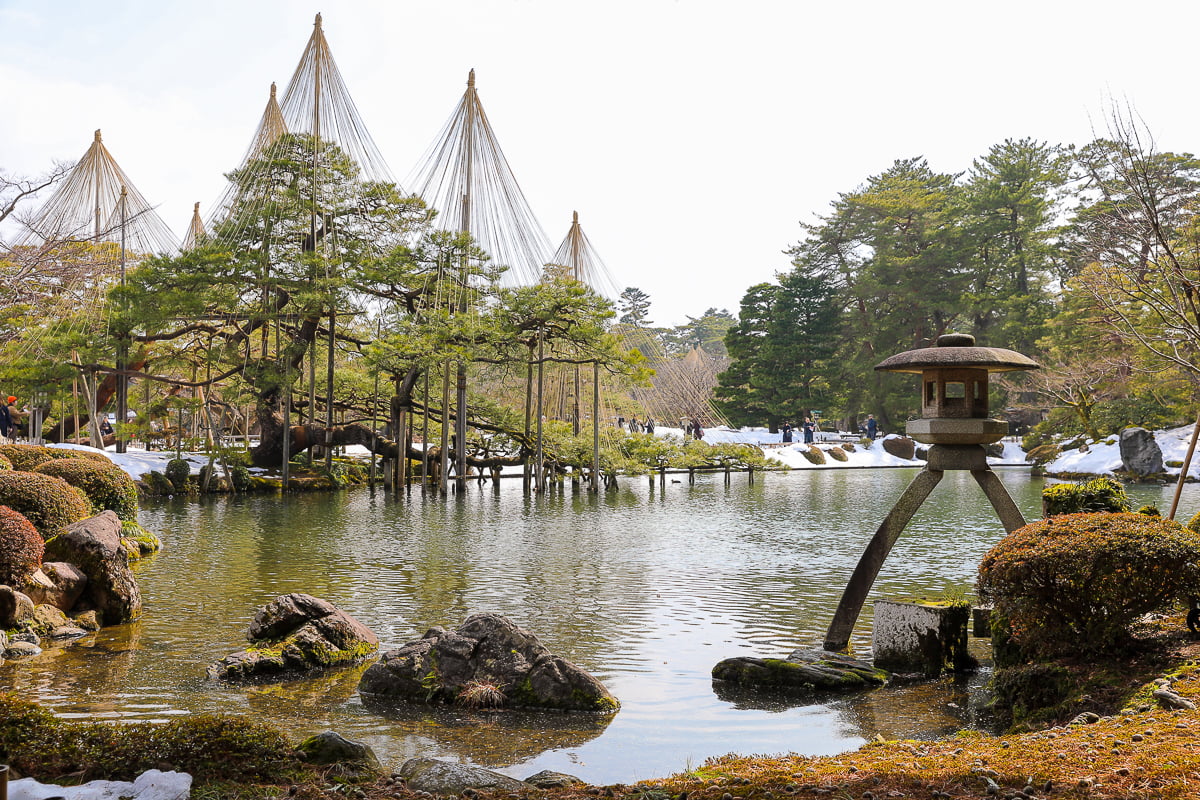
Kanazawa, Japan Travel Guide: A Quick Summary
Here’s a quick summary of my Kanazawa travel guide – which pairs perfectly with my Kanazawa foodie guide and 2-day Kyoto itinerary, by the way.
Best Hotels in Kanazawa:
- UAN Kanazawa ($$)
- Hotel Kanazawa Zoushi ($$$) – my top pick!
- SOKI Kanazawa ($$$)
- Maki No Oto Kanazawa ($$$$)
Best Things to Do in Kanazawa:
- Taste your way through Omicho Market on a food tour
- Stroll through the Higashi Chaya Geisha District, try wagashi, and discover local crafts
- Take a traditional Japanese cooking and sushi-making class
- Explore Kanazawa Castle
- Visit the Kenrokuen Garden – one of Japan’s most beautiful gardens
- Wander the Nagamachi Samurai District
- E-bike through Kanazawa and visit the Ninja Temple
- Make your own silver or gold ring at a workshop in Higashi Chaya
- Stop by the D.T. Suzuki Museum
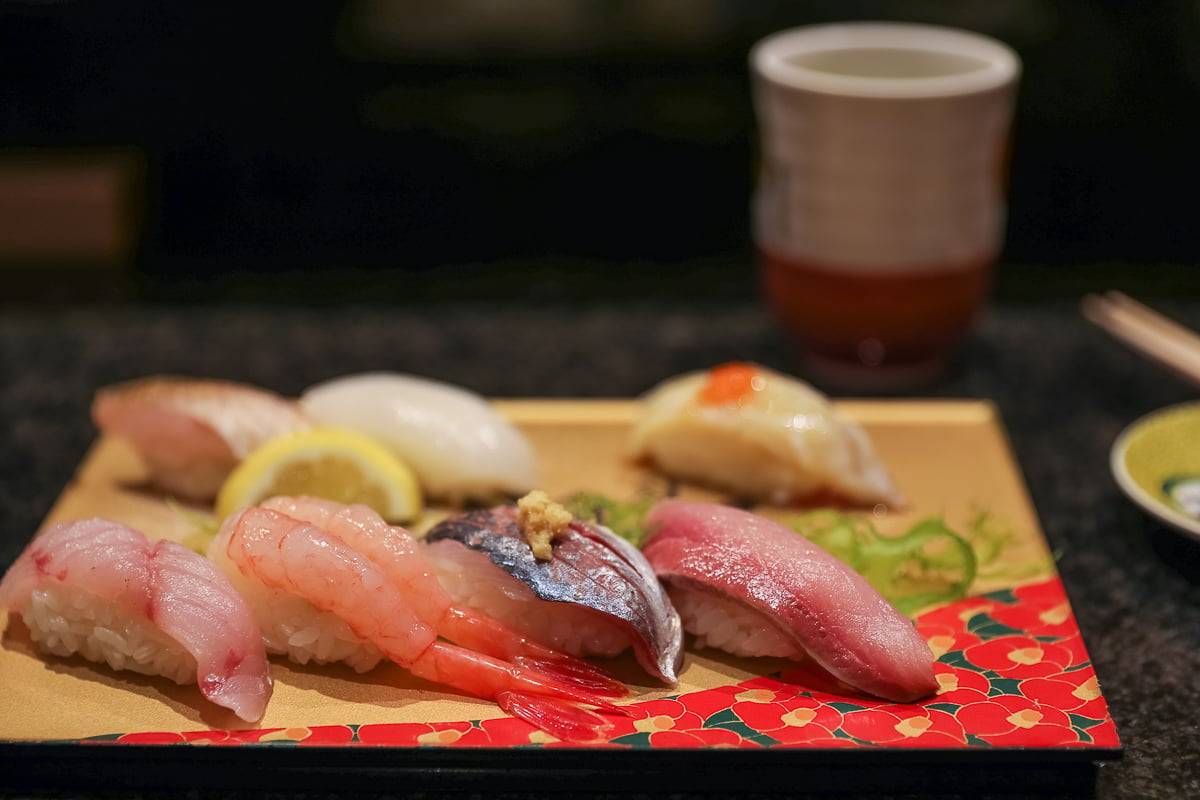
Where to Eat in Kanazawa:
From snow crab to Noto wagyu, Kanazawa’s food scene is next-level. See my Kanazawa restaurant guide for all my favorite spots.
Have More Time in Kanazawa?
Take a day trip to the UNESCO-listed mountain villages of Shirakawa-Go and Gokayama, or explore the wild coastlines and terraced rice fields of the Noto Peninsula.
How Many Days Do You Need in Kanazawa?
You could rush through Kanazawa’s highlights on a day trip from Kyoto or Osaka, but I don’t recommend it. Kanazawa deserves at least two full days.
With its walkable size, world-class food scene, beautifully preserved samurai and geisha districts, and peaceful gardens, Kanazawa is among the most interesting Japanese cities.
And even though it’s called “Little Kyoto” for its cultural richness, I think Kanazawa is 100x better than Kyoto – because it’s not an over-touristed amusement park for Instagrammers. (Thank God.)
With two days, you can explore Kenrokuen Garden, Kanazawa Castle, the Higashi Chaya geisha district, Nagamachi samurai district, and the Omicho Market – with stops for tea, handicraft shopping, and seafood along the way.
If you’re a foodie or art lover, stay three or four days. You'll have time to join a guided food tour, eat at the best restaurants, and visit art museums and workshops. You can even take a day trip to Shirakawa-go and Gokayama.
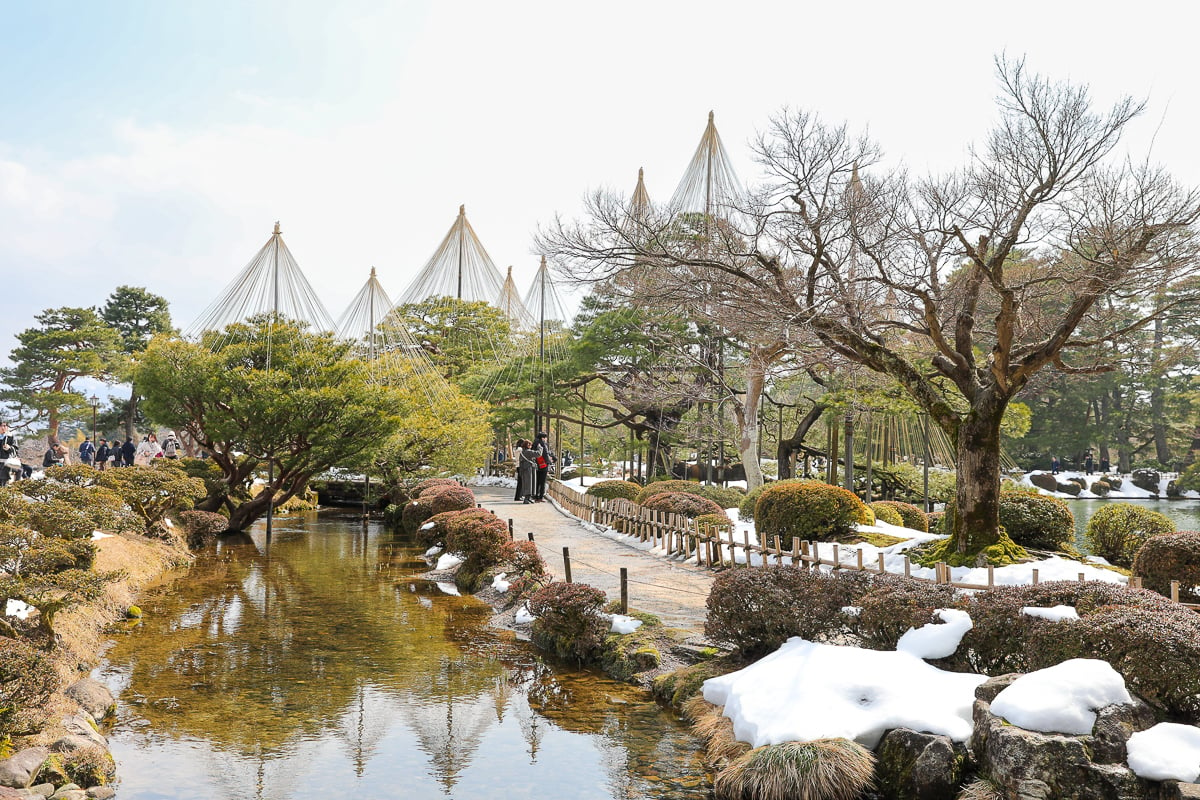
When to Visit Kanazawa (By Season)
- December-February: Bundle up (it’s freezing!) for Kanazawa’s peak foodie season. Expect snow-dusted gardens, quiet streets, and the best snow crab and yellowtail of your life. This is also when local Kaga vegetables are at their best.
- March-April: Still chilly but starting to warm up. Wild mountain greens appear on menus, cherry blossoms bloom (usually a week earlier than in Kyoto or Osaka), and the Kenrokuen Garden is spectacular.
- May-September: Locals told me that peak summer is the worst time to visit. May and early June are pleasant, but mid-June through August are sweltering, humid, and rainy. Unless you’re attending the Hyakumangoku Festival or the Kanazawa Fireworks Festival, skip summer. September is cooler with fewer tourists.
- October-November: Cool air, light crowds, and fall foliage make this another beautiful time to visit. It’s also when the last of the warm-water seafood (like sea bream and tilefish) meets the start of snow crab season.
Best Times to Visit Kanazawa
The top months to visit Kanazawa are November through March for minimal crowds and the best seasonal seafood and produce.
I think late winter is the absolute best time. We visited from Feb 22 to March 1st; it was peaceful, the seafood was perfect, and we saw Honshu’s very first cherry blossoms! It was cold, but we had very little snow or rain.
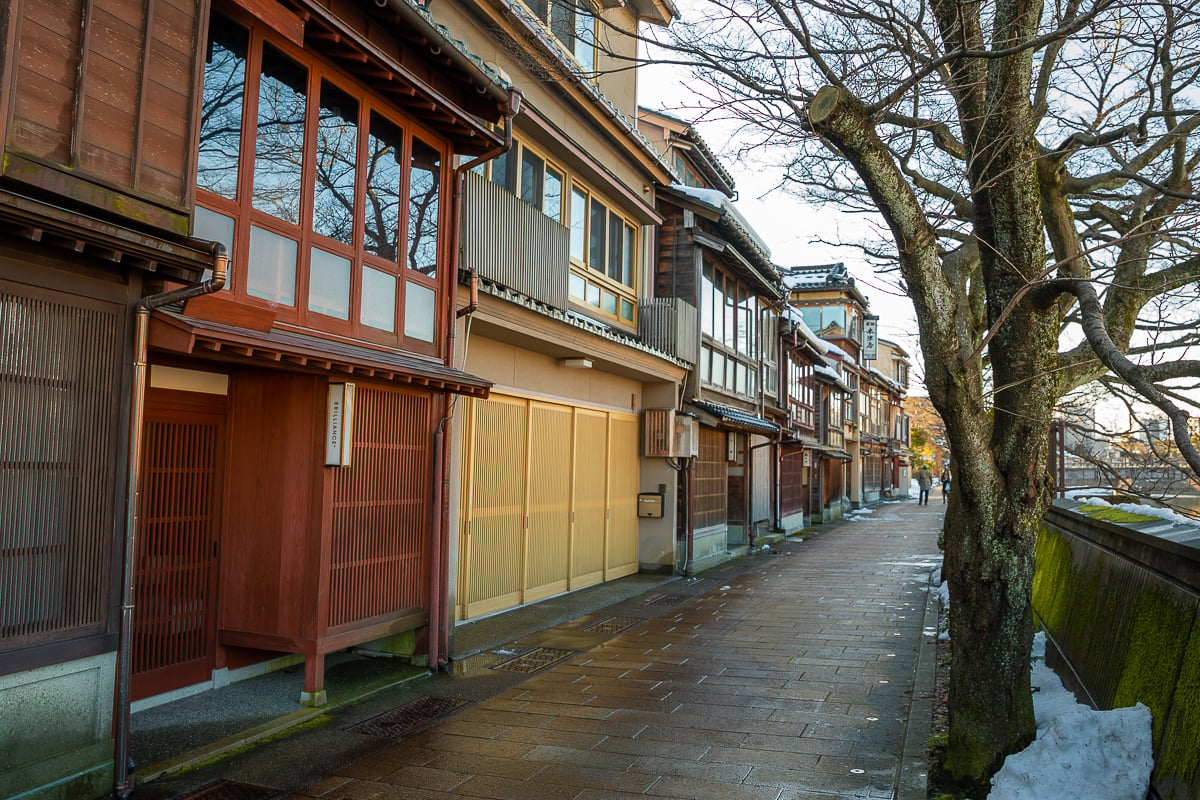
Where to Stay in Kanazawa
Kanazawa is steeped in long-held tradition and meticulous artistry – and the best hotels embrace just that. Expect native woods, stone accents, thoughtful design, and warm Japanese hospitality.
Since Kanazawa is compact, staying near Kanazawa Station and the Omicho Market (foodie heaven) is ideal. The more chances you have to slip inside the market for a grilled scallop or wagyu skewer, the better! From there, you can easily walk to must-sees like Kenrokuen Garden, Kanazawa Castle, and Higashi Chaya.
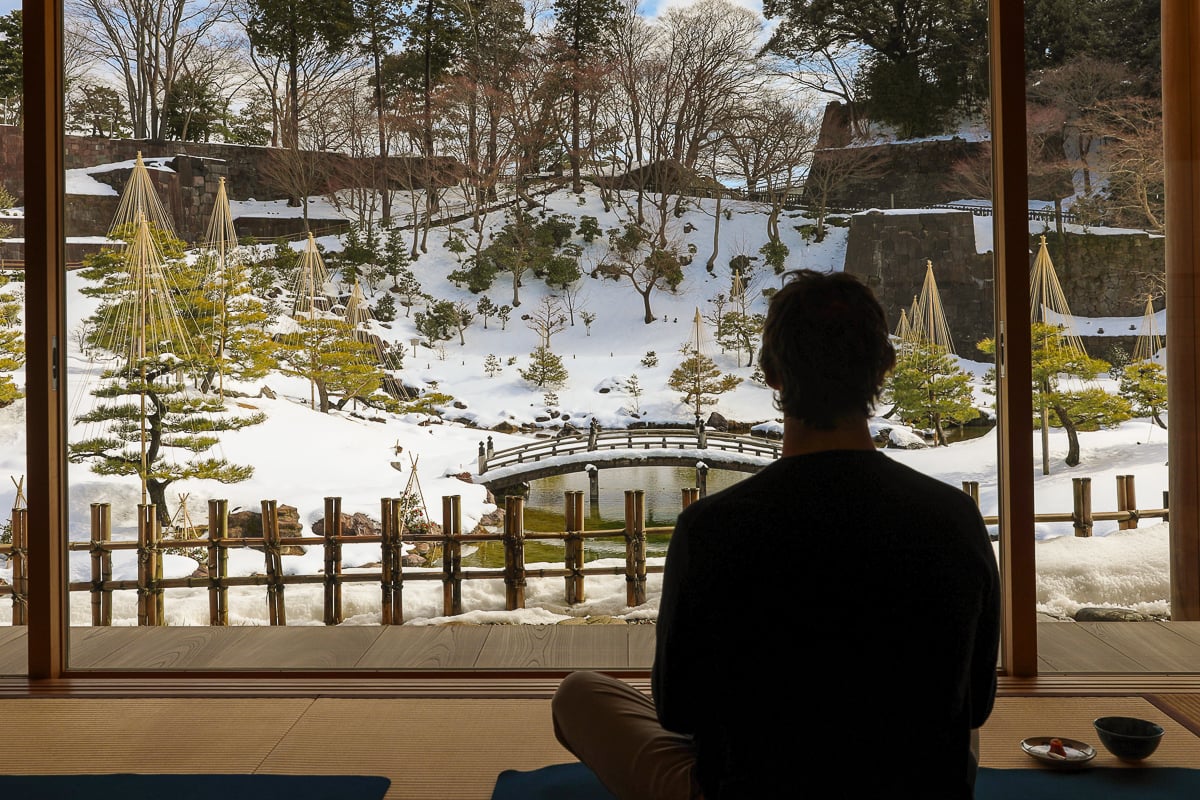
Best Hotels in Kanazawa
- UAN Kanazawa ($$): A short walk from Omicho Market, UAN blends modern design with traditional touches – tatami accents, soft lighting, and natural wood. The rooms are spacious and feature soaking tubs. Plus, complimentary bikes make it easy to explore the city.
- Hotel Kanazawa Zoushi ($$$): Nestled between the market and Kanazawa Station, this boutique hotel balances plush details and ryokan tradition. You’ll love the zen wood and stone accents, bonsai garden, and Japanese-style breakfast of seasonal, local ingredients.
- SOKI Kanazawa ($$$): Minimalist and peaceful, the rooms here feature tatami floors, low futon beds, and relaxing bathtubs. It’s steps from Omicho Market, and there's an on-site onsen.
- Maki No Oto Kanazawa ($$$$): This luxurious ryokan is set in Higashi Chaya, the main geisha district. With only four spacious suites, personalized service, and a small onsen, you’ll want to savor every moment.
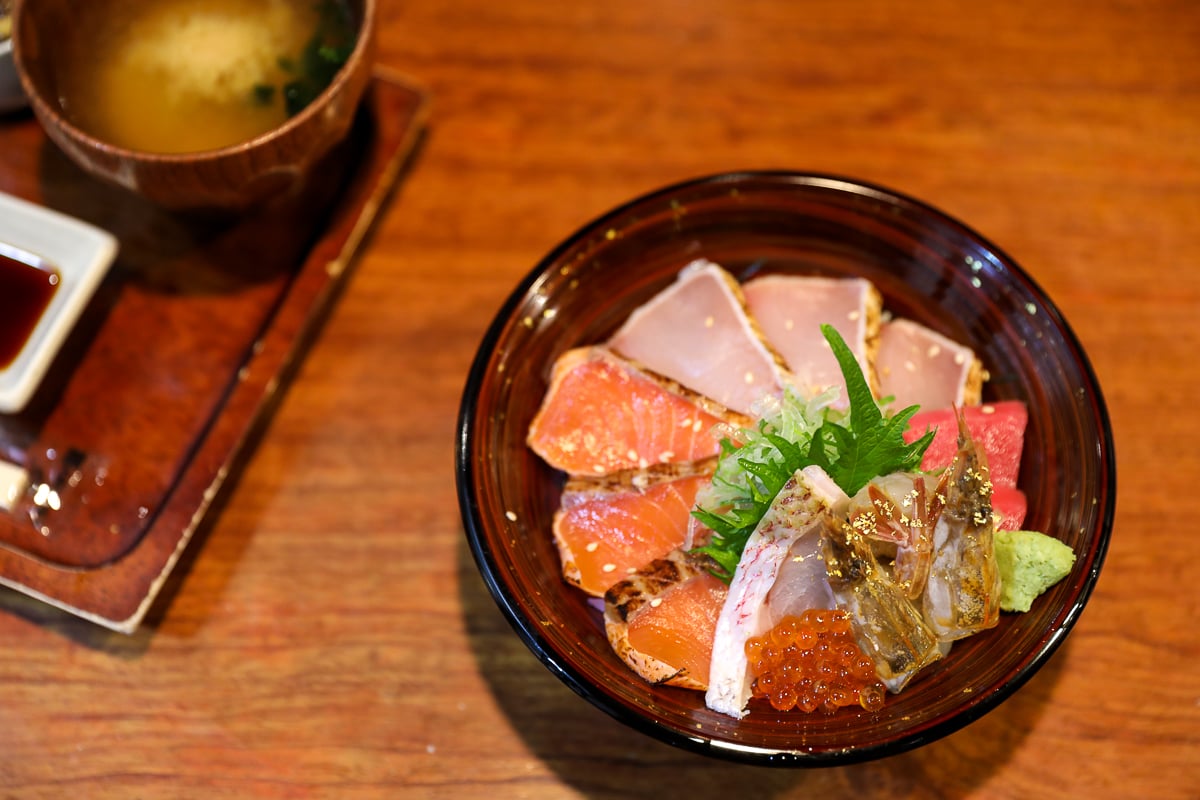
Top Things to Do in Kanazawa
Wondering what to do in Kanazawa? Kanazawa has it all: peaceful geisha districts, samurai streets frozen in time, a thriving craft and art scene (it’s a UNESCO-designated City of Crafts and Folk Arts), traditional markets, and the best seafood ever (arigatō, Sea of Japan!).
I spent a week soaking up every corner of this city. Here are my top picks for the best things to do in Kanazawa!
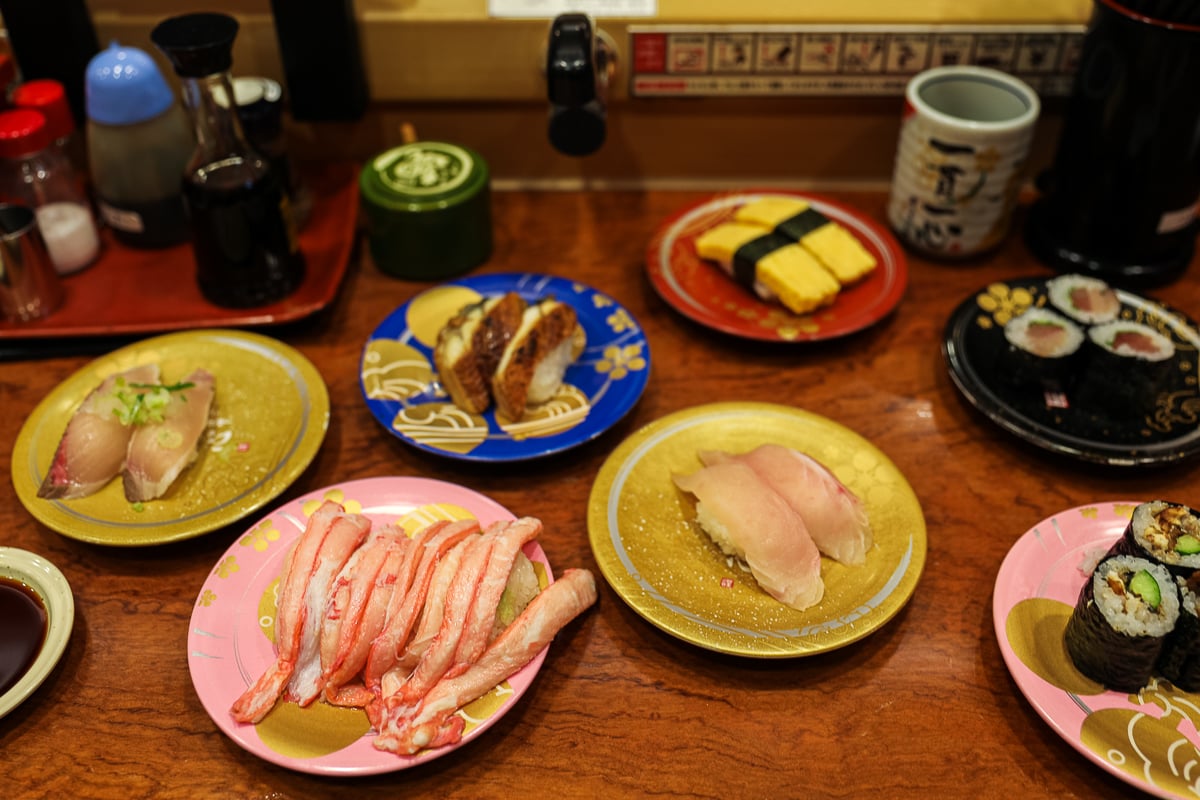
1. Explore Omicho Market
Omicho Market is Kanazawa’s beating, briny heart. For centuries, locals have come here to buy, sell, and eat the freshest seafood from the Sea of Japan – and today, there are more than 200 stalls and restaurants to choose from. It’s foodie heaven.
And the best way to experience it is through this Kanazawa foodie tour.
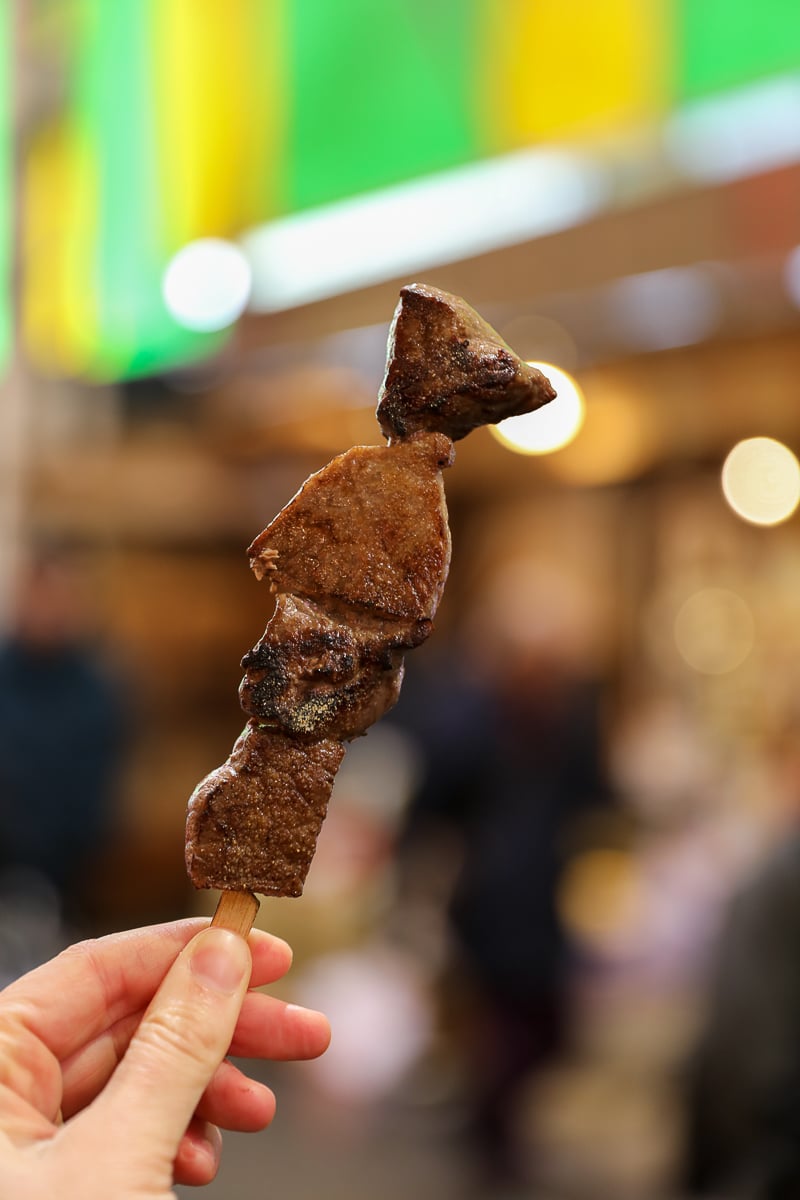
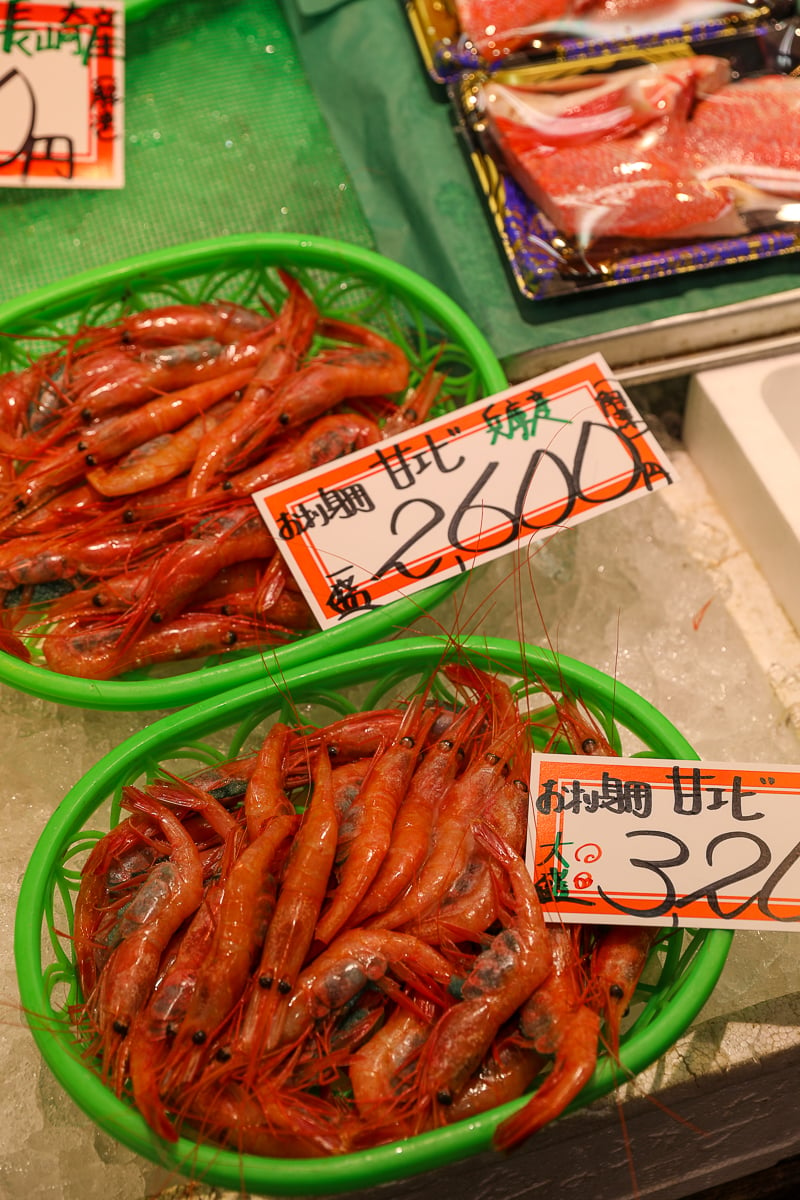
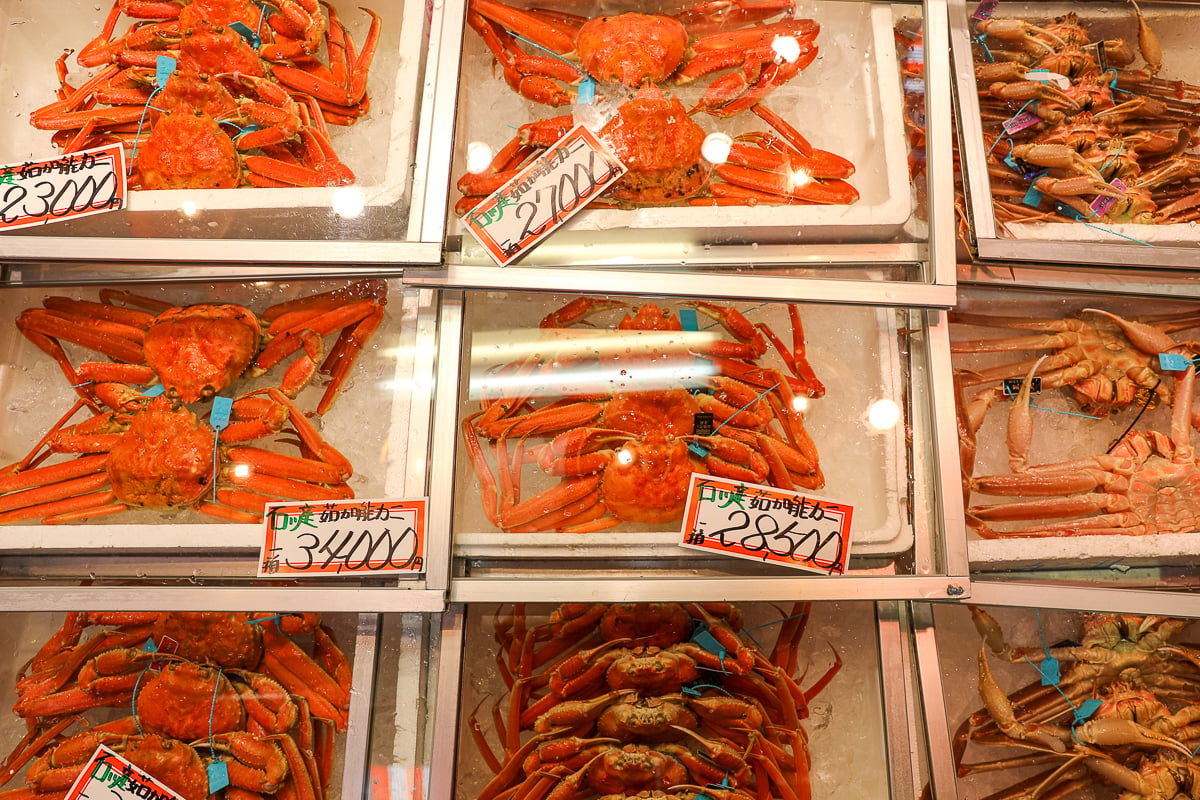
The stalls overflow with snow crab, glossy uni, rosy seabass, and platters of rainbow-colored sashimi. The veggie stalls are stacked high with Kaga vegetables and wild mountain greens, while shops serve Kanazawa-style oden and curry, Noto pork buns, crab croquettes, Noto wagyu skewers, and more.
And unlike Kyoto’s overcrowded, touristy-as-can-be Nishiki Market, Omicho is wonderfully local and true. You’ll rub shoulders with Kanazawa-jin doing their daily shopping. Not busloads of tourists.
You could easily spend hours eating your way through this market… Trust me, I did – more than once!
MADDY’S TIP: I went on this Taste of Kanazawa Food Tour, which covers Omicho Market and the Higashi Chaya geisha district. Our local guide led us to her favorite stalls, while sharing stories about Kanazawa’s food culture and history. This is the most delicious way to get to know Kanazawa, and I highly recommend it! Click here to book your Taste of Kanazawa Food Tour.
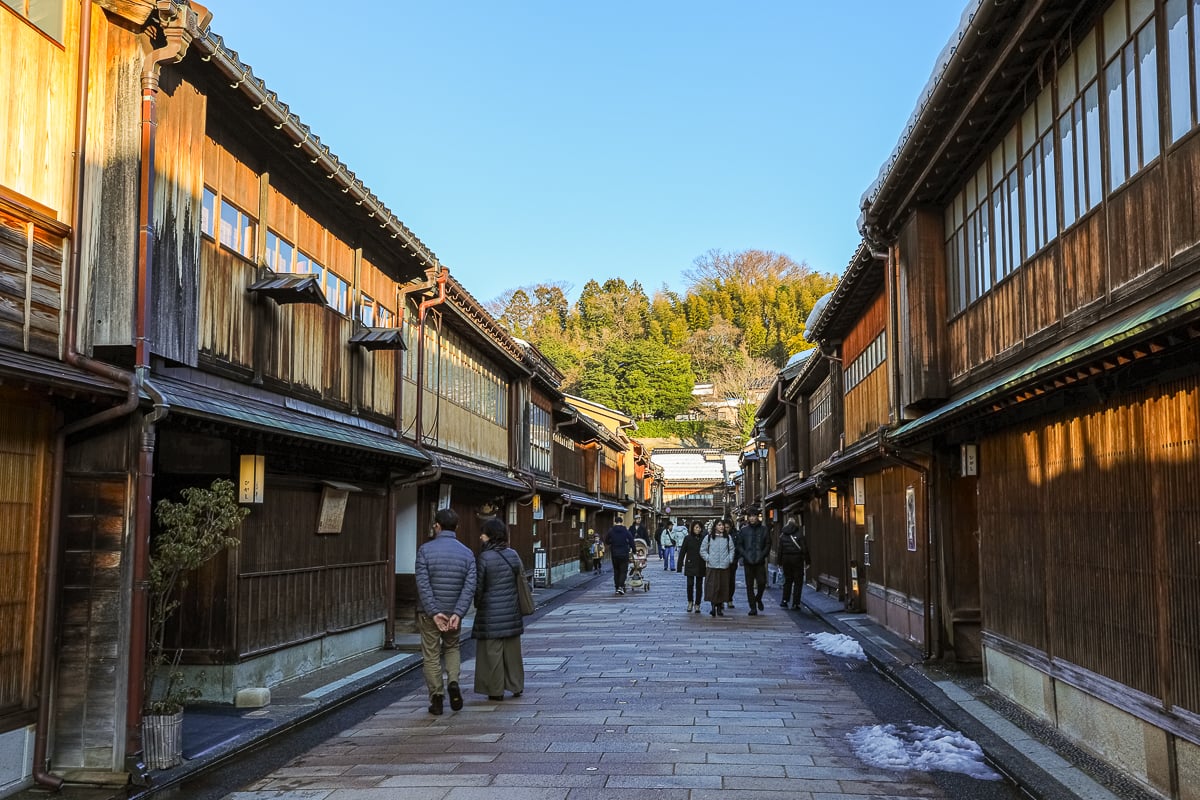
2. Explore the Higashi Chaya Geisha District
Higashi Chaya is Kanazawa’s most atmospheric neighborhood, and one of only three geisha districts in Japan officially recognized as a Cultural Asset.
Its name translates to “Eastern Teahouse,” and as you stroll its lantern-lit lanes, you’ll pass beautifully preserved wooden teahouses – where geisha still perform tea ceremonies, music, and dance – alongside shops selling wagashi (beautiful Japanese sweets), roasted tea, matcha, gold-leaf crafts, handmade jewelry, lacquerware, and even ice cream covered in gold leaf!
MADDY’S TIP: I visited Higashi Chaya as part of this Taste of Kanazawa Food Tour – and it was magic. We watched artisans hammering gold leaf, sampled sweets, and learned about Kanazawa’s geisha traditions. It’s the perfect way to experience this district’s culture, beauty, and flavor all at once. Click here to book your Taste of Kanazawa Food Tour!
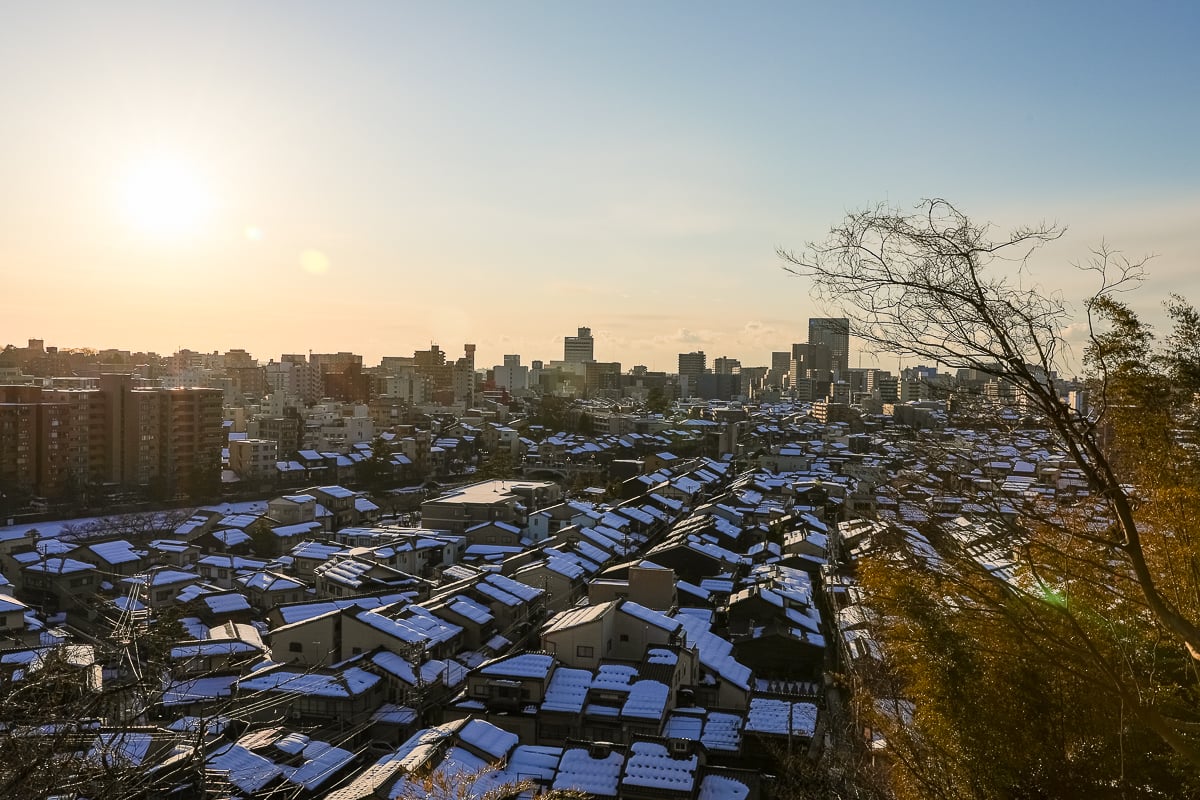
Things to Do in Higashi Chaya
- Climb up to Hosenji Temple for breathtaking views over Higashi Chaya and the rest of Kanazawa.
- Join this ring-making workshop to design and make your own silver or gold ring.
- Pop into Oriental Brewing for a local craft beer flight.
- Stop by the Yasue Gold Leaf Museum to learn more about Kanazawa’s artisan heritage.
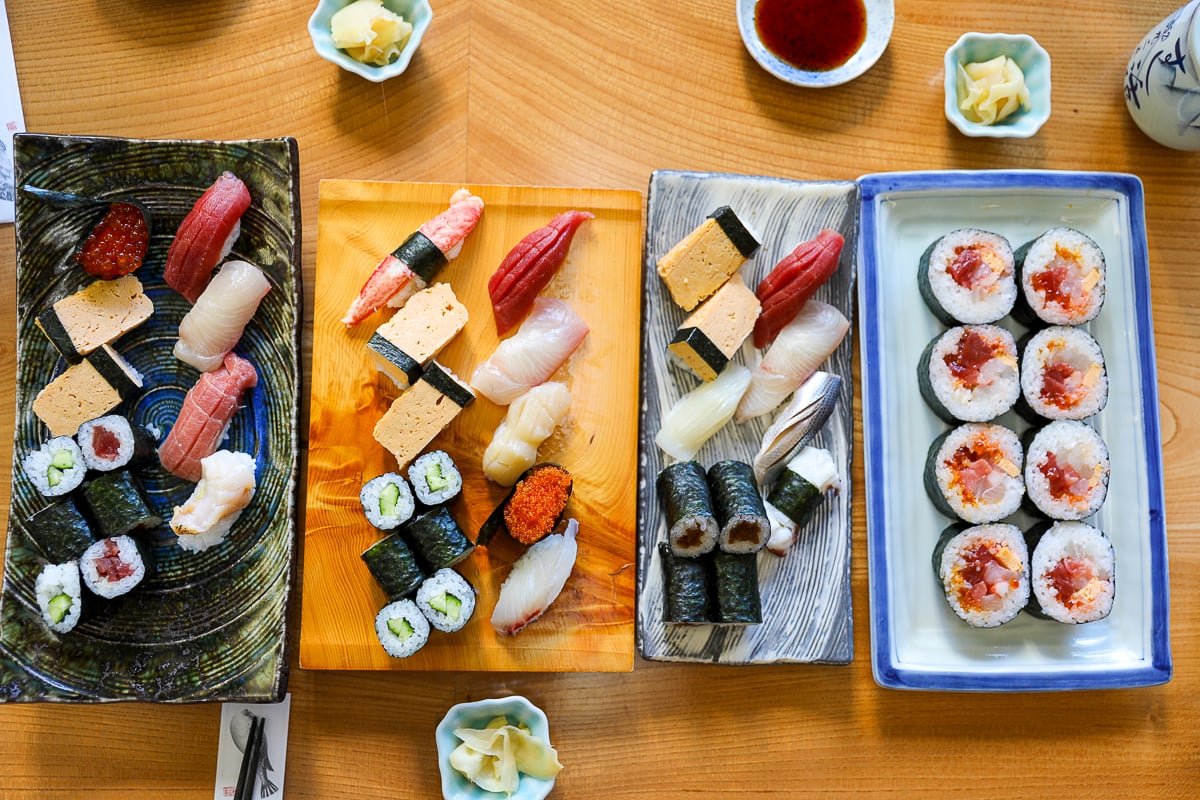
3. Take a Japanese Cooking & Sushi-Making Class
If you love Japanese food as much as I do, don’t miss this hands-on traditional Japanese cooking and sushi-making class led by a local chef.
You’ll don a traditional itamae (sushi chef) kimono-style coat and apron, and learn to make a variety of Japanese dishes: seasonal appetizers, nigiri sushi, tamagoyaki (rolled omelets), miso soup, jibu-ni (a local duck stew), and mochi for dessert. You even get to use the school's premium, razor-sharp Japanese knives!
Then you'll savor it all, alongside a glass of local sake or Kanazawa plum wine.
If you’re anything like me, you will become obsessed with sushi-making… And you’ll be counting down the days until you can make it again at home.
I highly recommend this experience! Click here to book your traditional Japanese cooking and sushi-making class!
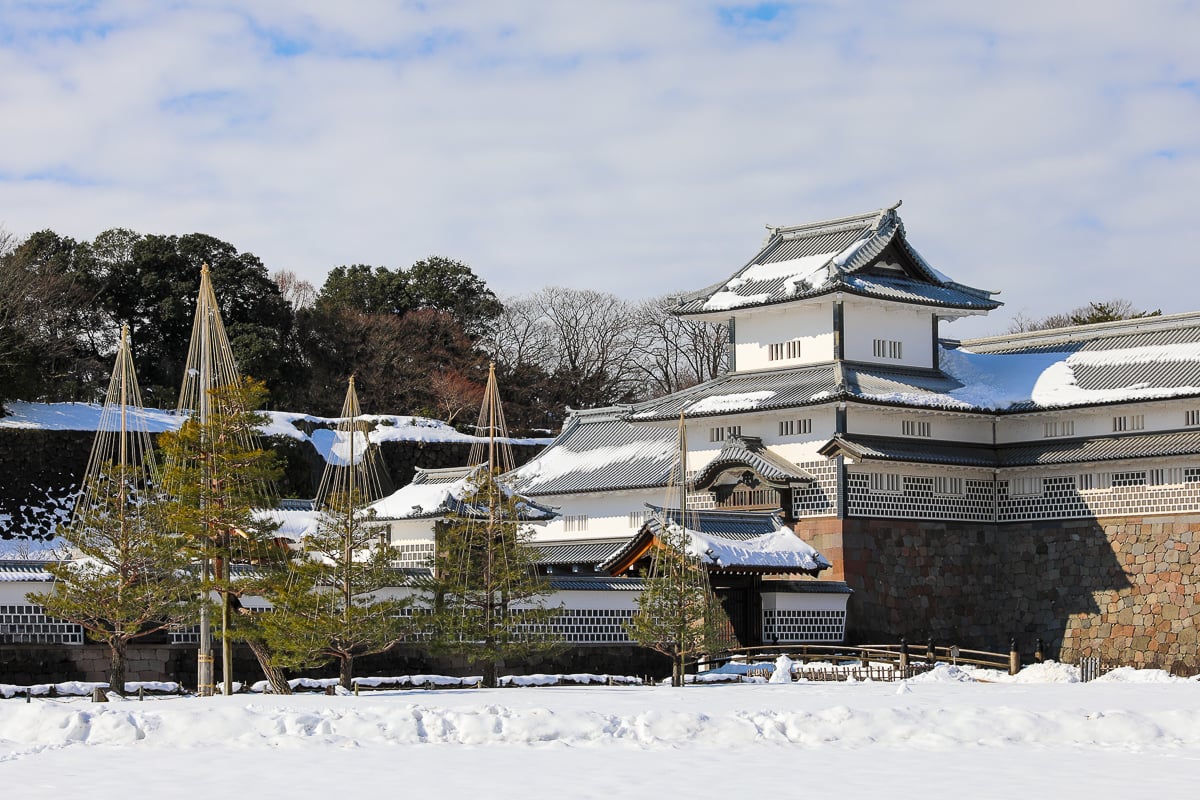
4. Visit Kanazawa Castle
Just a 10-minute walk from Omicho Market (or 25 minutes from Kanazawa Station), Kanazawa Castle is one of Japan’s most beautiful castles – and a symbol of Kanazawa’s powerful samurai past.
The castle was first built in the late 1500s by the Maeda clan, feudal lords who ruled the Kaga Domain for more than 300 years. They were Japan’s second-wealthiest family and funded many of the artistic, architectural, and culinary traditions that still define Kanazawa today
Parts of the original castle burned down, but the gates, stone walls, and turrets have been restored using traditional Edo-era carpentry techniques. No nails, just wooden joinery!
I loved walking through the massive wooden gates and along the moats, imagining samurai guards patrolling the grounds! You only need an hour to see it all.
MADDY’S TIPS: The castle grounds are free to explore and connect to Kenrokuen Garden, so you can visit both at once. Local volunteer guides offer free English tours of Kanazawa Castle – well worth joining to understand the castle’s layered history and symbolism.
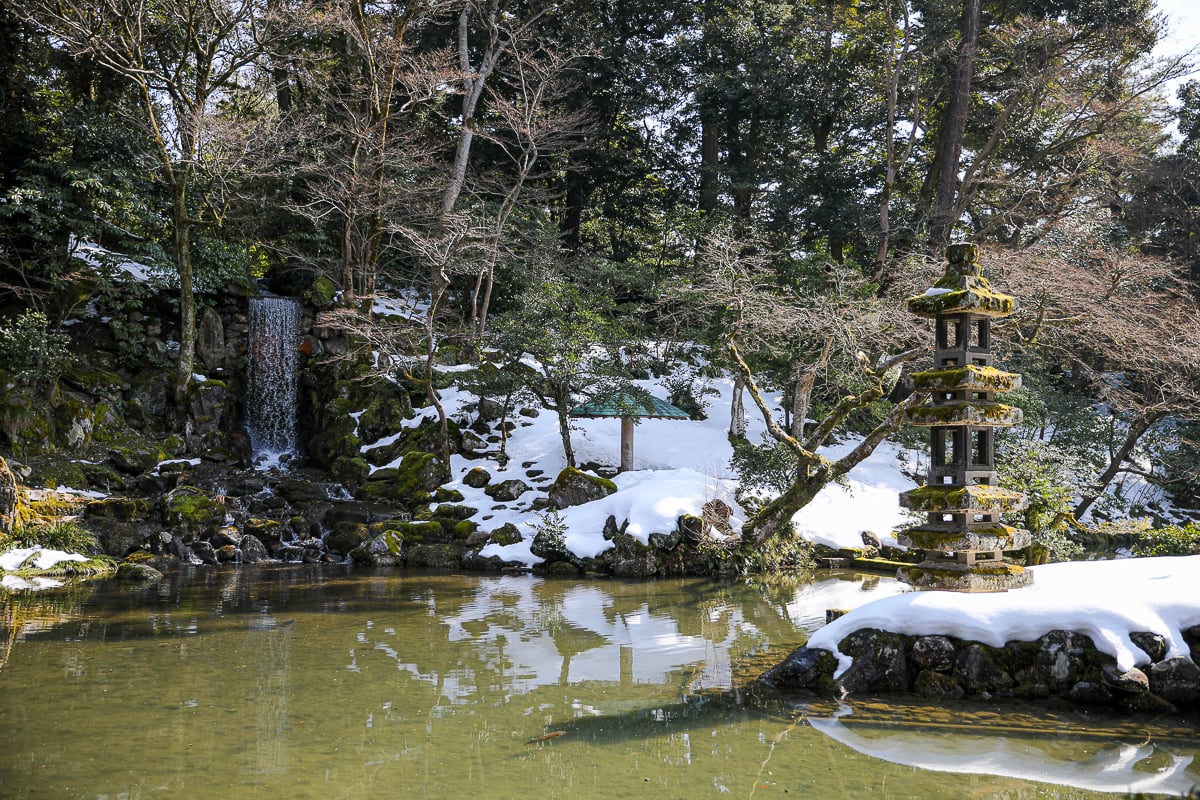
5. Wander Kenrokuen Garden
Kenrokuen Garden is considered one of Japan’s three most beautiful gardens. And I can confirm – it lives up to the title!
Its name means “Garden of Six Attributes,” nodding to the six elements that create the “perfect” landscape: spaciousness, seclusion, artifice, antiquity, water, and scenic views.
As you wander, you’ll find mirror-like ponds, meandering paths through mossy pines, sculpted bridges, teahouses, and shrines tucked between the trees.
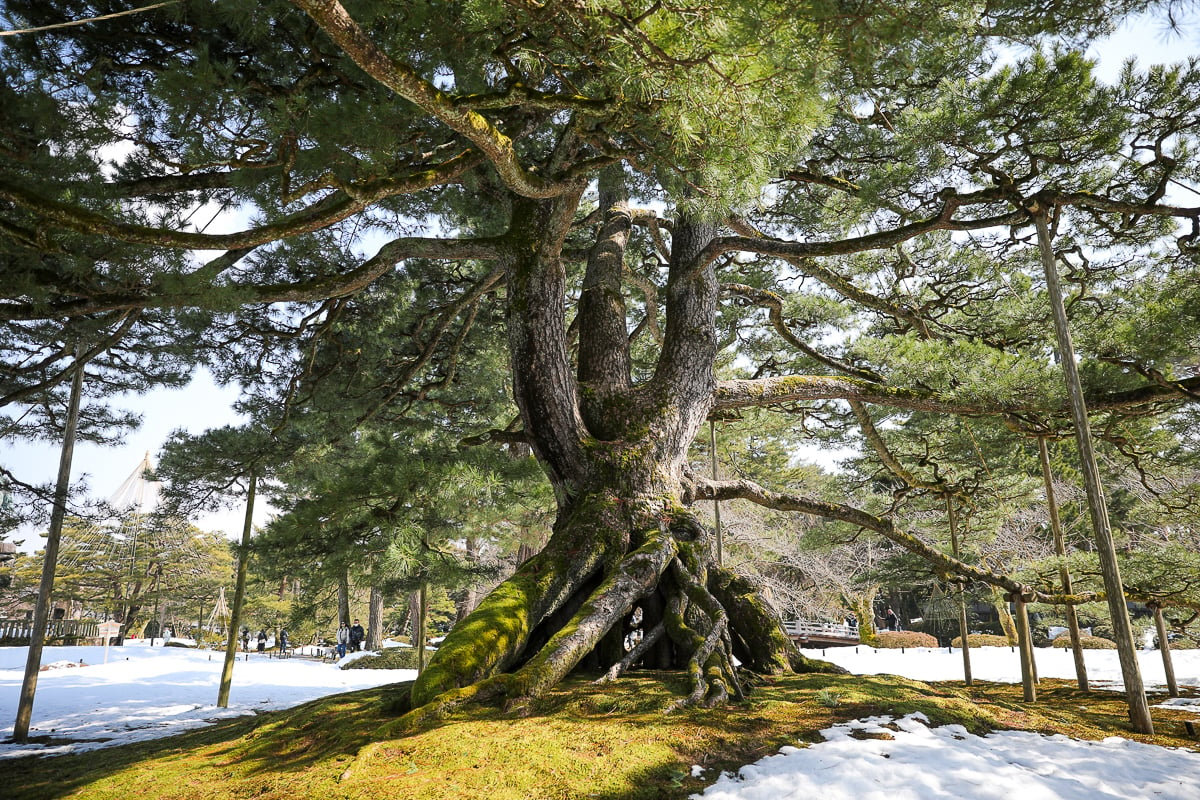
I visited in late winter, and the snow made the garden look calm and ethereal. Seeing the cherry blossoms in spring, or the fiery foliage in autumn, would be equally magical! Sitting by Kasumigaike Pond and watching koi swim beneath the Kotojitoro Lantern (an iconic Kanazawa landmark!) was my highlight.
The gardens are usually open from 7 AM to 6 PM (March-October) and 8 AM to 5 PM (October-February). It's best to go first thing to avoid any crowds. It costs ¥320 (about $2 USD) to enter.
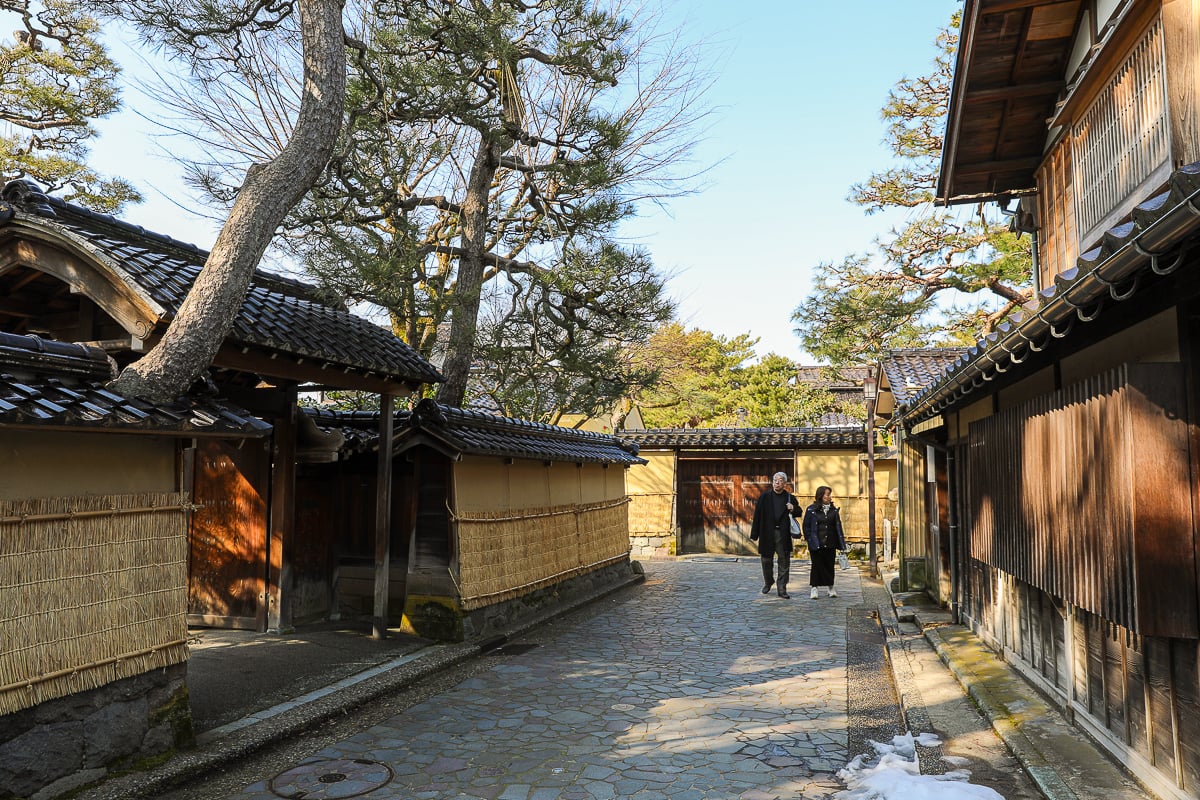
6. Step Back in Time in the Nagamachi Samurai District
Just a short walk from Kanazawa Castle, the Nagamachi Samurai District feels like stepping back to the Edo era. This was once home to Kanazawa’s samurai class, where the Maeda lords granted land to their most trusted warriors.
The mud walls (tsuchikabe), narrow cobblestone lanes, and wooden gates are beautifully preserved – since, luckily, Kanazawa escaped the bombings of WWII. We visited on a sunny afternoon and couldn’t believe how quiet it was.
The whole neighborhood is calm, nostalgic, and untouched by time – except that some homes have been converted into potter or antique shops. Pop inside to browse and admire the traditional architecture!
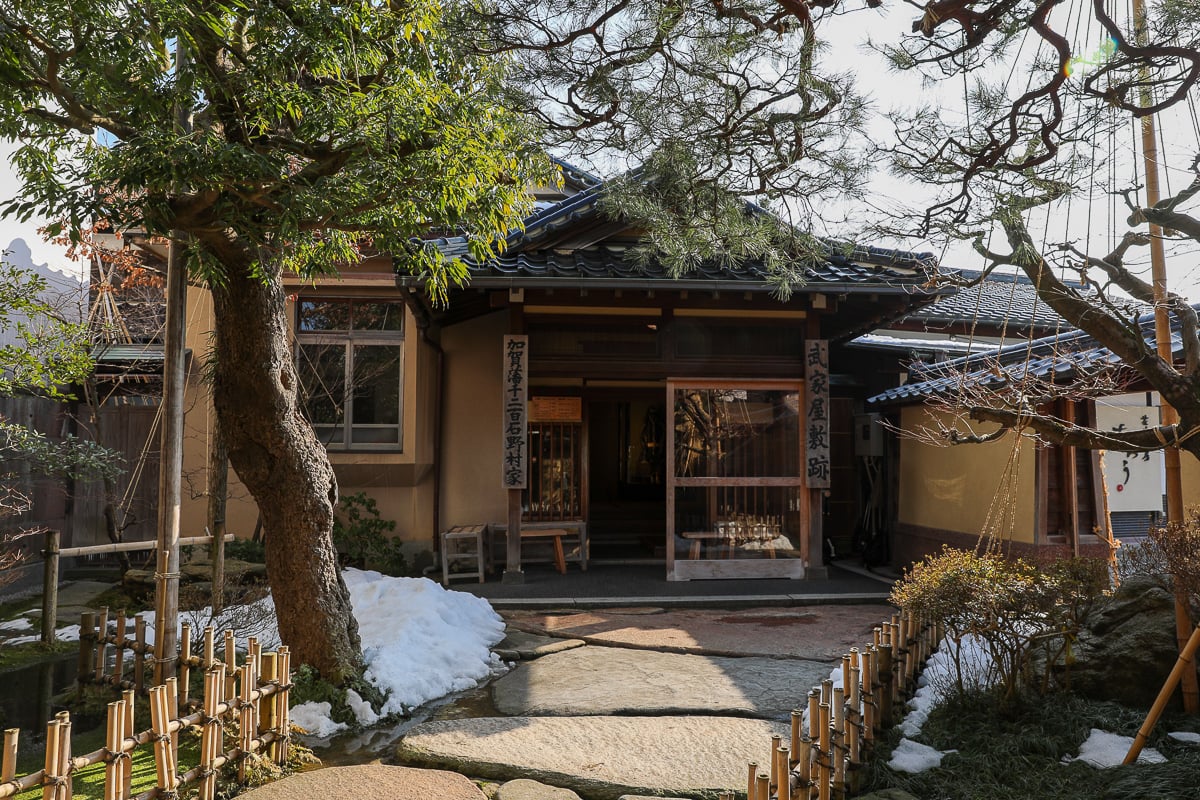
Don’t miss the Nomura Samurai House (Nomura-ke), a restored residence filled with samurai artifacts, scrolls, swords, and armor. Inside, you’ll also find a beautiful garden and a tearoom where you can pause for matcha. Entry costs ¥550 (about $4 USD).
MADDY’S TIP: For a pre- or post-walk coffee, head to Isotope or Townsfolk Coffee nearby – I loved both!
7. Visit the D.T. Suzuki Museum
If you need a moment of stillness in your Kanazawa itinerary, I have just the place for you. The D.T. Suzuki Museum is a minimalist, modern space dedicated to Suzuki Daisetz Teitaro – the Kanazawa-born philosopher who introduced Zen Buddhism to the West.
The highlight is the Water Mirror Garden, where sunlight, water, and silence blur into one meditative experience.
This museum is the perfect place to slow down and reflect between sightseeing stops. It’s open Tuesday through Sunday, 9:30 AM to 5:00 PM (last entry 4:30 PM). Entry costs ¥310 (about $2 USD).
8. Tour the Ninja Temple (Myoryuji)
Despite the nickname, Myoryuji (A.K.A. the Ninja Temple) has nothing to do with ninjas! Still, touring it is one of the most fascinating things to do in Kanazawa.
Its stealthy reputation comes from its ingenious Edo-era design to outwit enemies. Constructed by the Maeda clan in 1643, this Buddhist temple was a stronghold in disguise – full of hidden staircases, trapdoors, secret escape routes, and even false ceilings.
Visits are by guided tour only (about 40 minutes), and you have to book by phone in advance; your hotel or the Kanazawa Tourist Information Center can help.
Admission is ¥1,200 (about $8 USD), and photography inside isn’t allowed.
MADDY’S TIP: Like e-biking? This half-day e-biking tour of Kanazawa includes a guided stop at the Ninja Temple, along with other hidden local spots! Click here to book your e-biking and Ninja Temple tour.
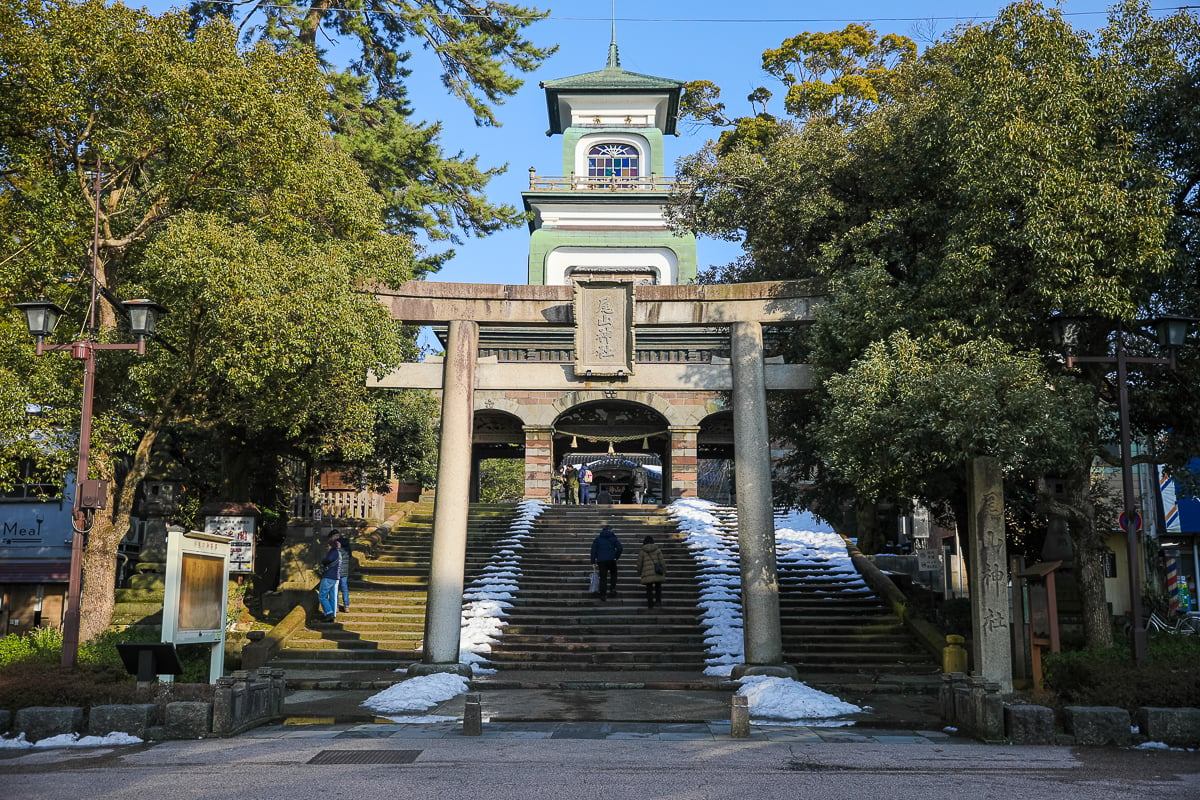
More Things to Do in Kanazawa
Have extra time in Kanazawa? Here are a few more experiences worth adding to your list!
- Nishi Chaya District: Kanazawa’s quieter, lesser-known geisha district is lined with traditional teahouses and local craft shops. When we visited, we had this charming neighborhood entirely to ourselves!
- Ring-Making Workshop: Craft your own silver or gold ring in a local Higashi Chaya studio and leave with a beautiful souvenir. Click here to book your ring-making workshop!
- Oyama Shrine: A peaceful Shinto shrine with a striking stained-glass gate and a koi-filled pond just steps from Kanazawa Castle. This was one of the most underrated places we visited – so beautiful!
- 21st Century Museum of Contemporary Art: This famous modern art museum features rotating exhibitions by international and Japanese artists, a circular, glass-walled design (it’s an architectural masterpiece by SANAA), and a peaceful outdoor sculpture garden.
Best Day Trips from Kanazawa
The countryside surrounding Kanazawa is just as enchanting as its geisha districts and markets. Here are the best day trips from Kanazawa!
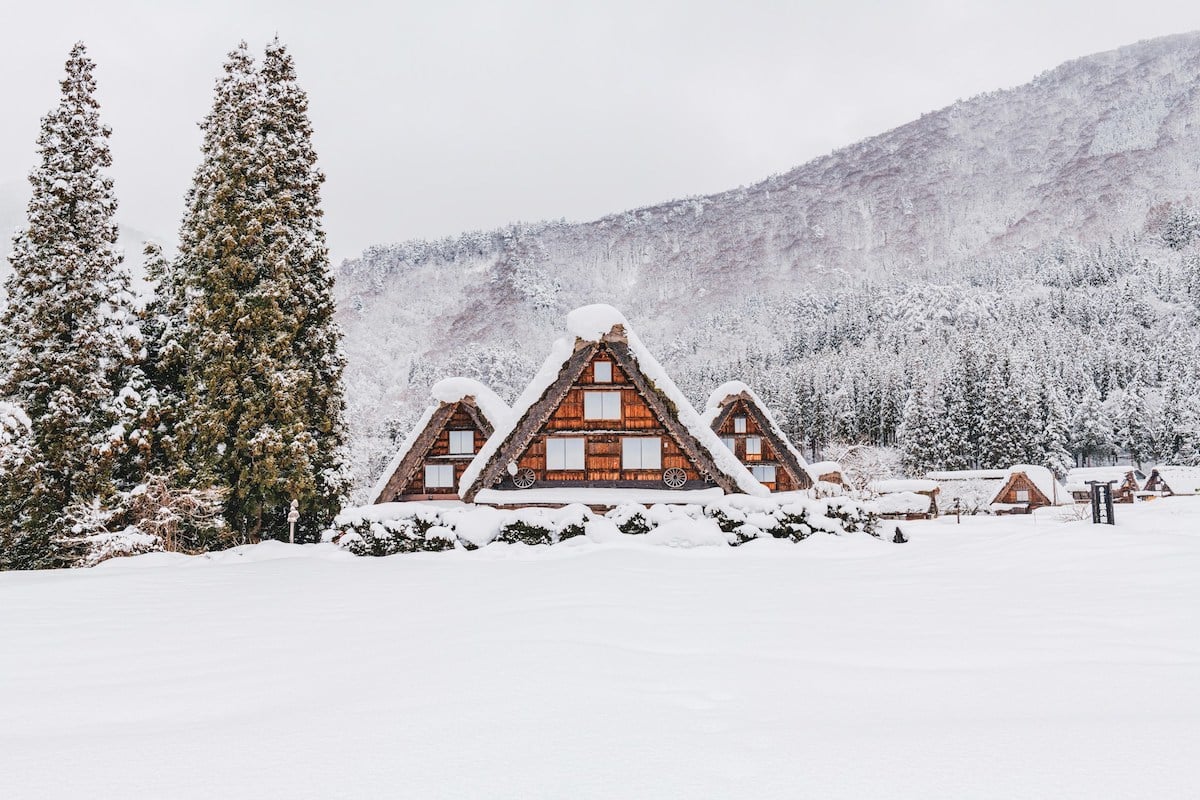
Visit Shirakawa-go and Gokayama
Take a full-day trip to Shirakawa-go and Gokayama and step into my idea of a Japanese fairytale.
Tucked deep in the Japanese Alps, these UNESCO-listed mountain villages are among the most beautiful – and culturally unique – places in Japan.
Shirakawa-go and Gokayama are famous for their gasshō-zukuri farmhouses, with steeply pitched, thatched roofs designed to withstand Gifu Prefecture’s heavy alpine snowfalls (sometimes over 15 feet deep!).
Many of these 250-year-old farmhouses are still inhabited, while others operate as minshuku (guesthouses) where you can stay overnight and enjoy home-cooked, mountain-style meals. Consider staying overnight at Shiroyamakan for a once-in-a-lifetime experience!
On this day trip from Kanazawa, you’ll explore both charming villages, browse local craft shops, and enjoy a traditional Hida-style lunch starring wild mountain vegetables, richly marbled Hida beef, and local river fish.
Whether blanketed in snow or surrounded by lush green rice fields, these villages are worth visiting year-round. Click here to book your day trip to Shirakawa-go and Gokayama.
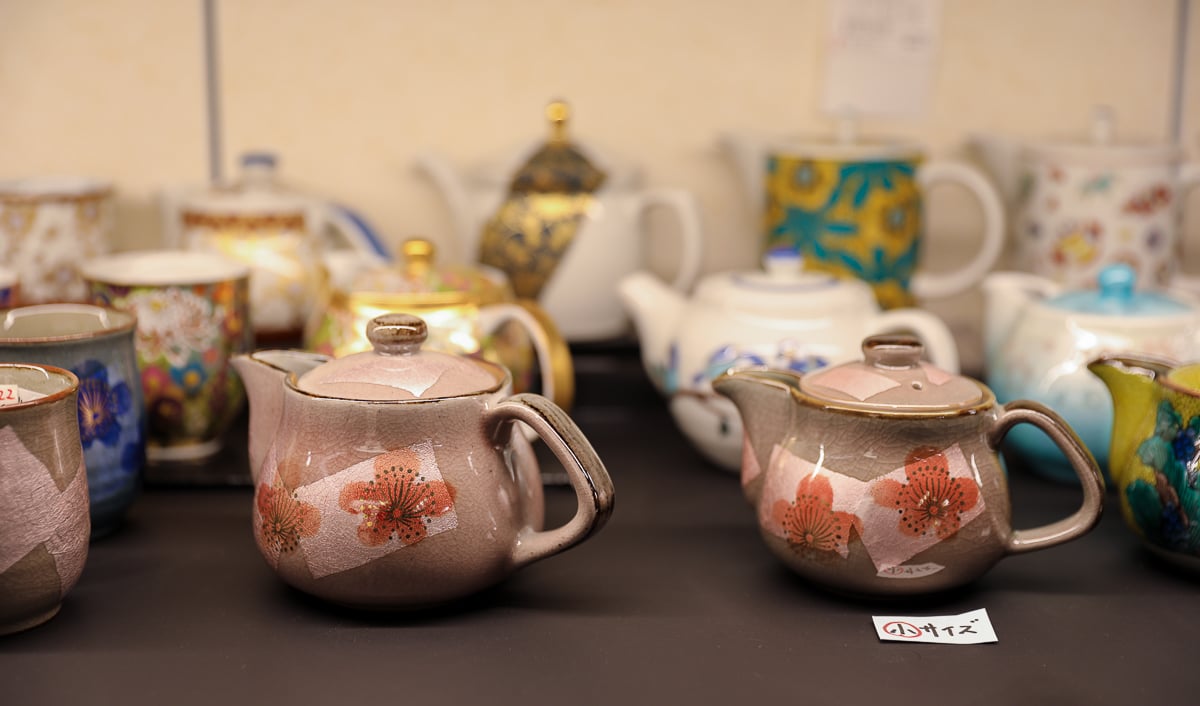
Explore the Scenic Noto Peninsula by Car
If you're craving the wild, coastal side of Ishikawa, the Noto Peninsula delivers quiet roads, cascading rice fields, cliffside sea vistas, and fishing towns in abundance.
You can either self-drive for full flexibility (click here to rent a car in Kanazawa) or opt for this full-day private tour of the Noto Peninsula to let your guide navigate while you enjoy the views.
On a full-day drive, you can head north through Wajima, known for its traditional lacquerware and lively morning market. There, you can join a hands-on workshop to make your own chopsticks to take home! Continue along the coast to the Shiroyone Senmaida Rice Terraces, where you’ll see hundreds of rice paddies tumbling into the Sea of Japan.
Then, cruise along the Chirihama Nagisa Driveway – a sandy beach that’s open to cars. Finally, cap off your adventure with a Noto-style meal before looping back to Kanazawa.
Click here to book your guided full-day tour of the Noto Peninsula.
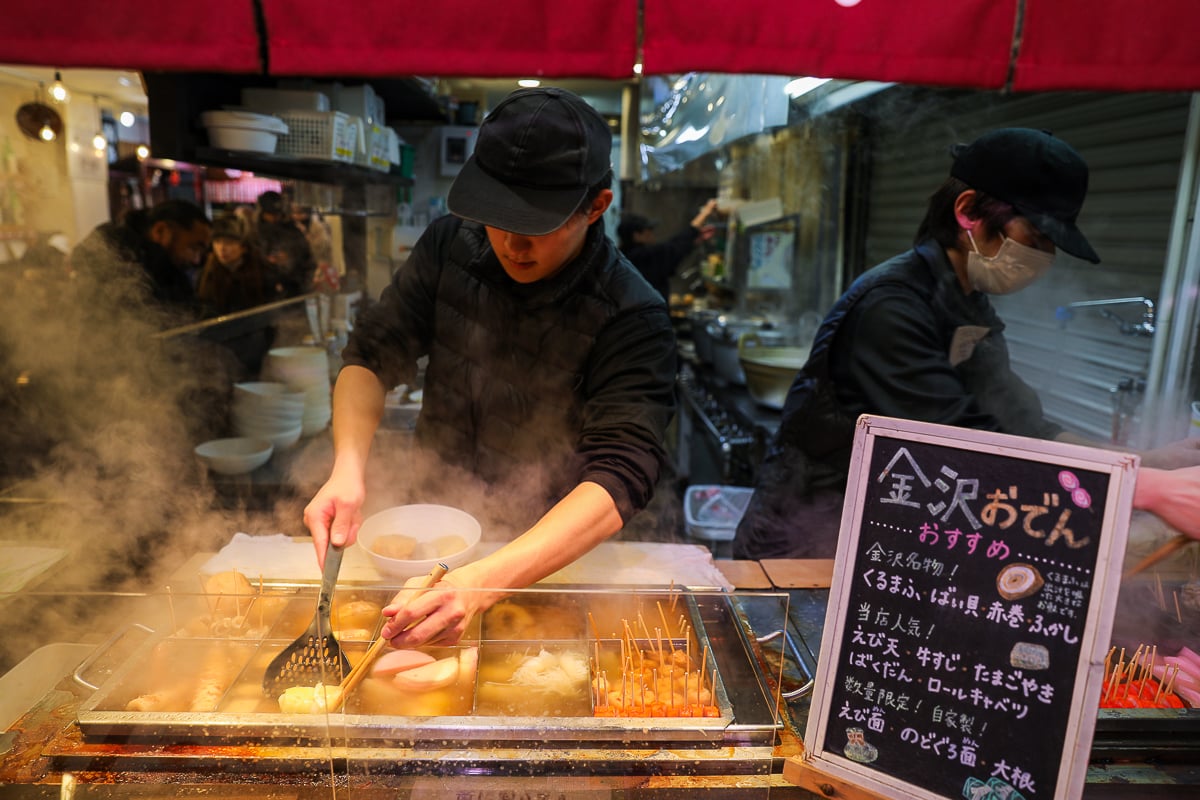
What to Eat in Kanazawa
Kanazawa is one of Japan’s best food cities, thanks to its proximity to the Sea of Japan and the bounties of the Noto Peninsula. Authentic, abundant, and deeply traditional, the food here is as good as it gets.
Snow crab (kano-gani), oysters, sea urchin (uni), yellowtail (buri), scallops (hotate), sea bream (tai), and rosy seabass (nodoguro) are the stars of the show. And incredibly affordable, since they're coming straight from the source! Of course, eating sushi and kaisendon (sashimi bowls) is non-negotiable.
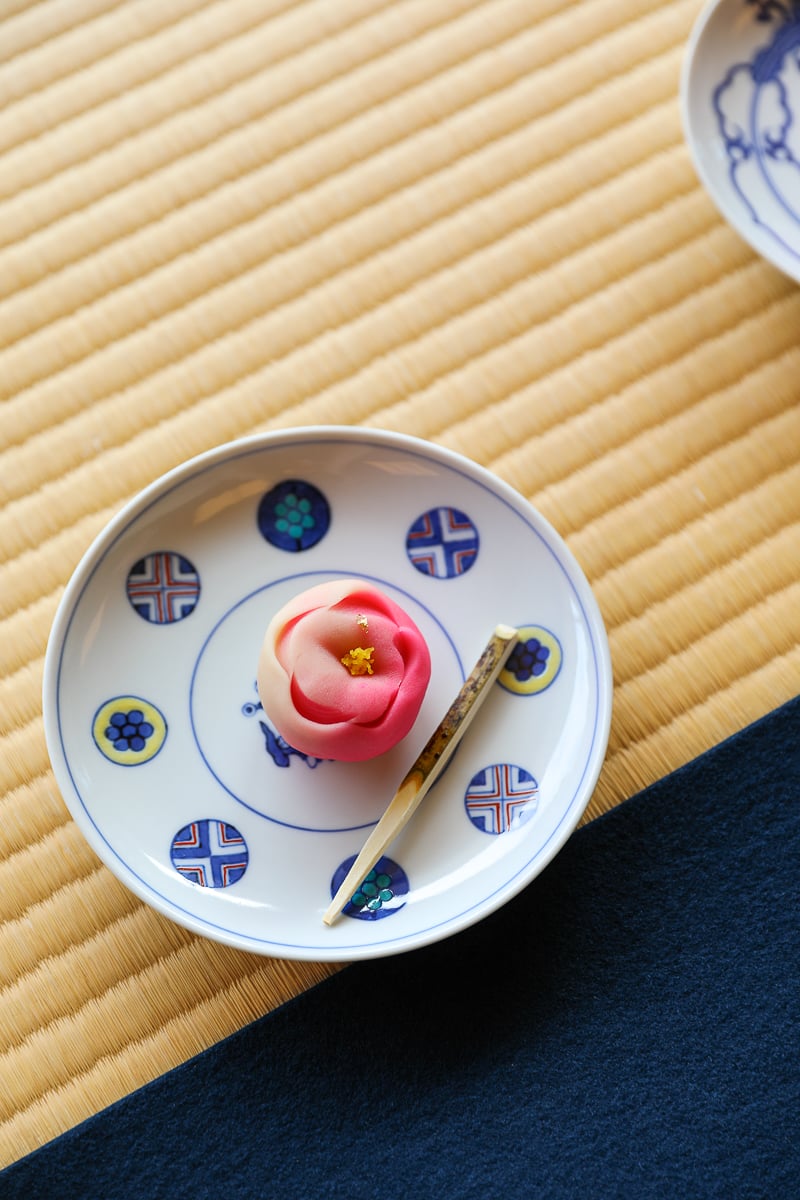
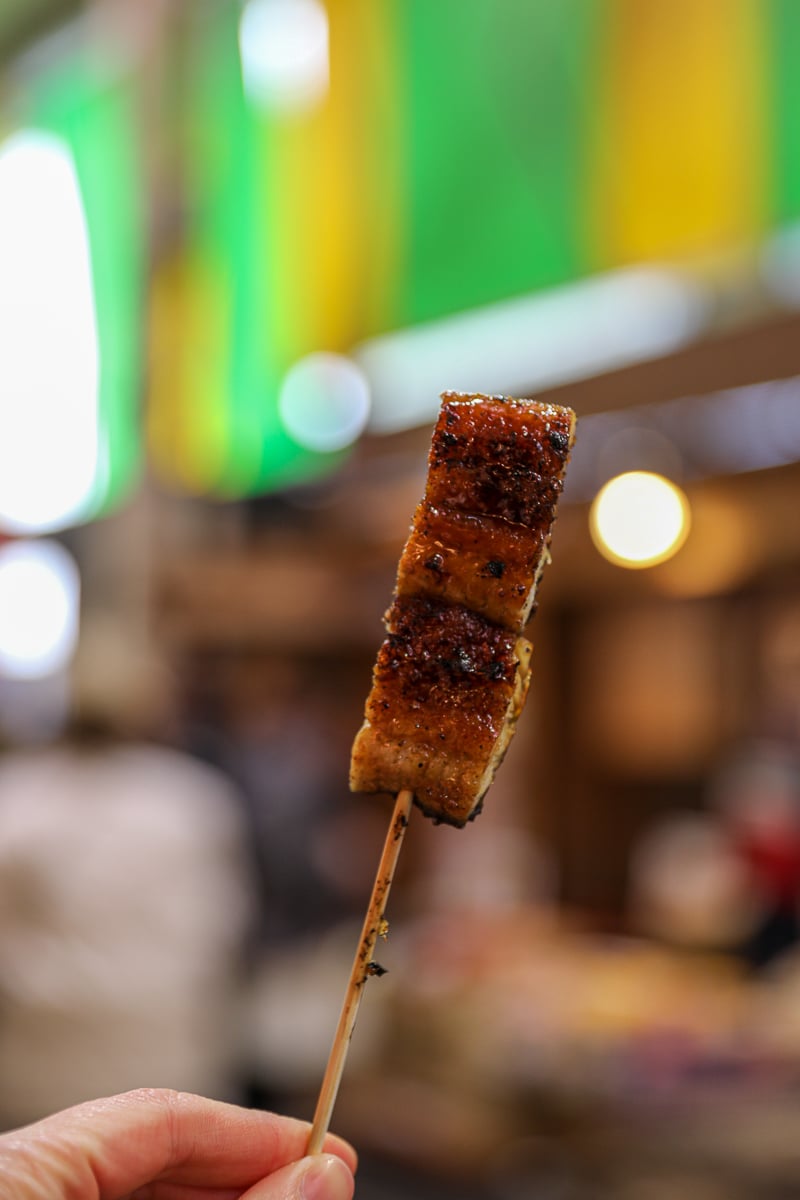
But Kanazawa’s cuisine goes far beyond the sea – thanks to fragrant local rice, Noto wagyu beef and pork, wild mountain herbs, native Kaga root vegetables and gourds, and mineral-rich sea salt.
Add these dishes to your must-try list: Kanazawa oden (an umami-packed hot pot), Kaga vegetable tempura, rich Kanazawa-style curry, Noto pork tonkatsu, hibachi-grilled Noto wagyu, gold-flecked wagyu nigiri, crab croquettes, jibu-ni (a sweet-salty duck stew), bean-paste wagashi sweets, and gold-leaf-covered matcha ice cream.
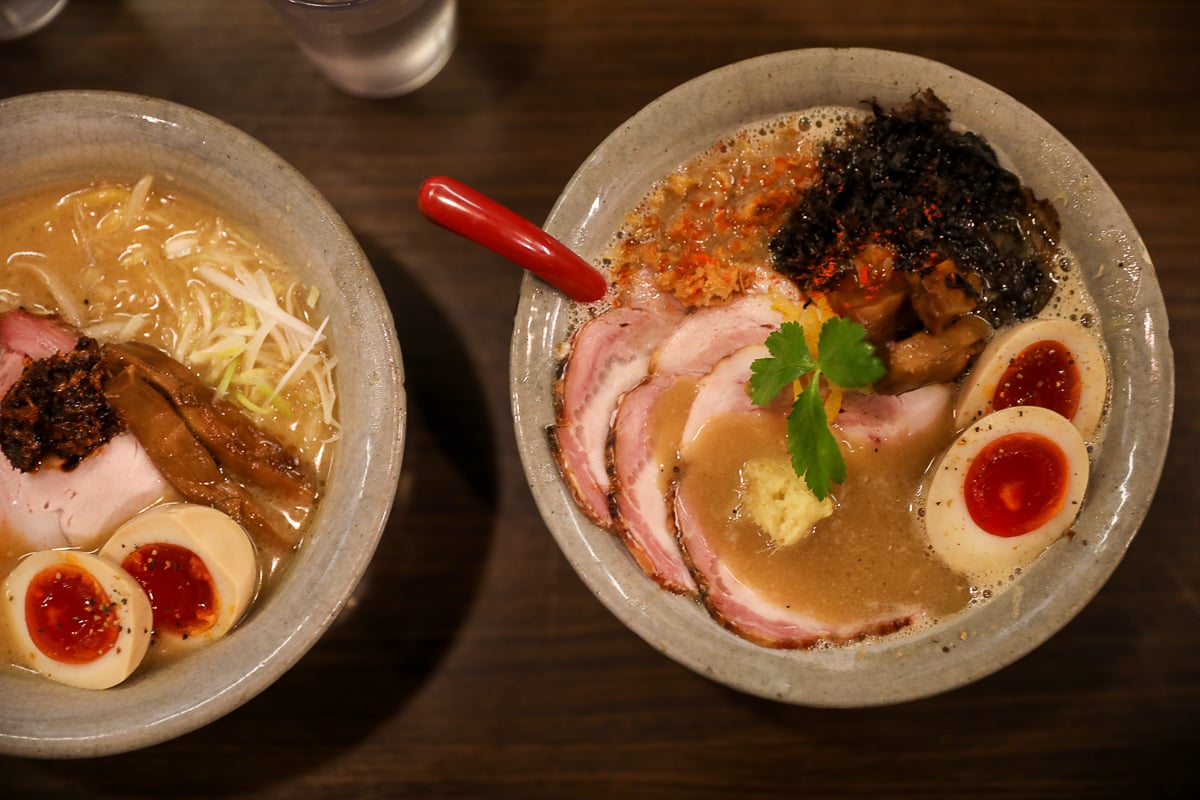
Where to Eat in Kanazawa
From the city’s best sushi bars, izakayas, street food stalls, and beyond, I wrote an entire guide on where to eat in Kanazawa, Japan. But here’s a quick snapshot of some of my favorite eateries:
- Ramen Taiga: For a umami-packed bowl of seasonal crab miso ramen with Noto pork – unbelievable!
- Ushioya: For kaisendon (sashimi bowl) perfection inside Omicho Market.
- Mori Mori Sushi: The best sushi train in the city – fresh, fun, and delicious!
- Kanazawa Curry Laboratory: For rich, chocolatey Kanazawa-style curry, topped with crispy, sweet Noto pork tonkatsu.
READ MORE: Traveling around Japan? I also have a guide on where to eat in Sapporo, Japan!
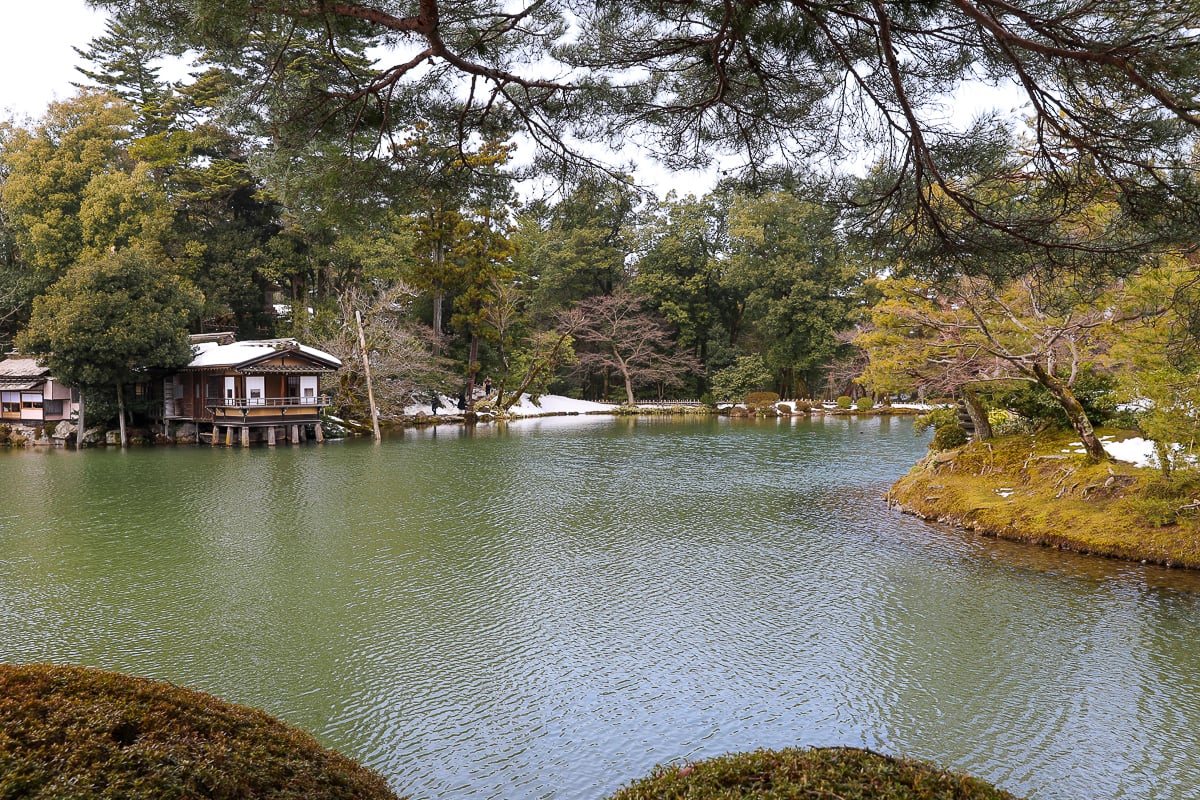
How to Get to Kanazawa
Kanazawa doesn’t have its own airport, but it’s easy to reach Kanazawa Station by train from Japan’s major cities.
- From Tokyo: Take the Hokuriku Shinkansen from Tokyo Station to Kanazawa Station – the journey takes about 2.5 to 3 hours.
- From Kyoto or Osaka: Take the Limited Express Thunderbird train directly to Kanazawa – about 2 hours from Kyoto or 2.5 hours from Osaka.
- From Toyama or Takayama: Regular trains and highway buses connect Kanazawa with both cities – about 1 hour from Toyama or 2 hours from Takayama.
- Driving: If you’re road-tripping through Japan, Kanazawa is an easy, scenic drive from the Japanese Alps or the Noto Peninsula. Paid lots near Kanazawa Station and Omicho Market offer hourly and overnight parking.
MADDY’S TIP: One of my favorite parts of Japan travel is same-day luggage forwarding! Use Black Cat (Yamato Transport) to send your bags from hotel to hotel so you can explore hands-free. Your hotel receptionist can help you set it up!

Getting Around Kanazawa
Kanazawa is compact and easy to navigate. Most major sights are within a 10- to 30-minute walk of each other. We explored purely on foot, and only used taxis to travel between Kanazawa Station and our hotel on arrival/departure.
- On foot: The city is flat and scenic, with riverside walks and pedestrian-friendly streets – especially around the geisha and samurai districts.
- By taxi: Hail a taxi or use Uber for quick, affordable trips across town.
- By bus: The Kanazawa Loop Bus and Kenrokuen Shuttle connect major attractions. A single ride is usually ¥200 for adults (¥100 for children), with reduced fares on weekends and holidays. A One Day Pass covers unlimited bus travel for ¥800 for adults (¥400 for children).
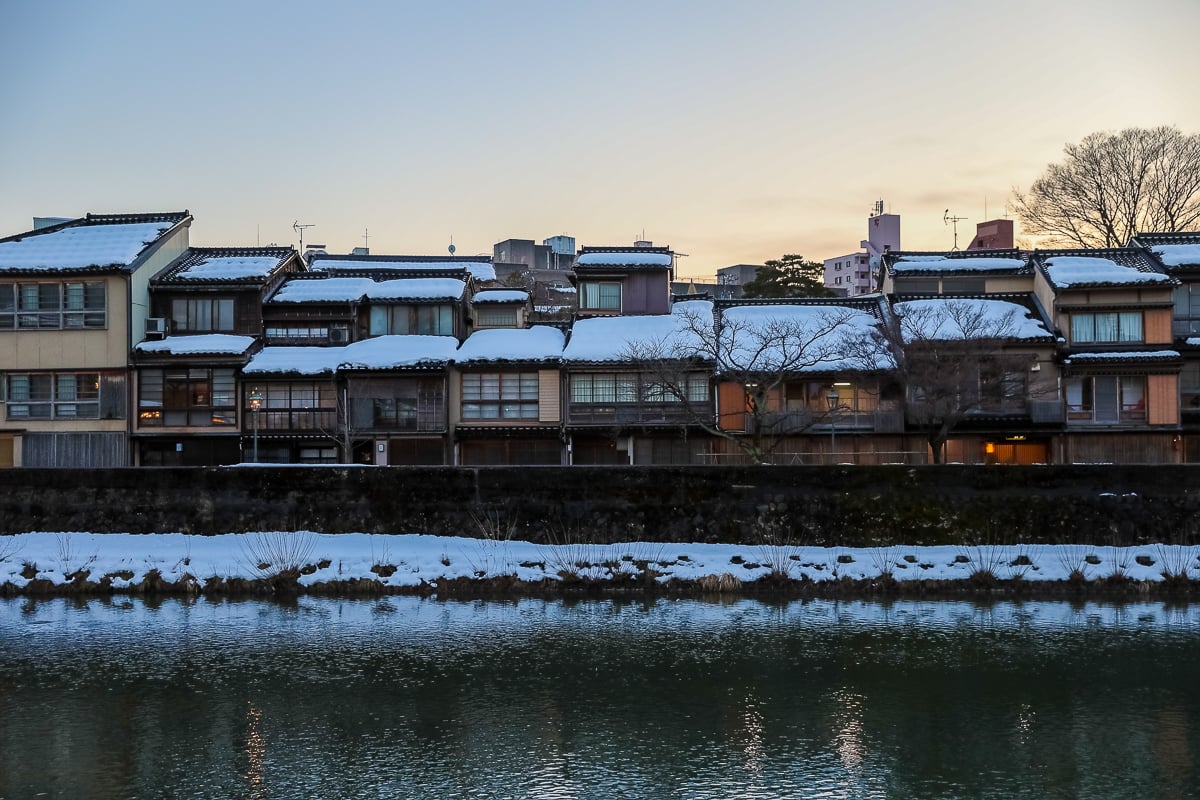
Practical Travel Tips for Kanazawa
- Language: English isn’t widely spoken, but Kanazawa-jin are warm, patient, and genuinely eager to help. A few words of Japanese – konnichiwa (hello), arigatō gozaimasu or simply arigatō (thank you), sumimasen (excuse me), and konbanwa (good evening) go a long way! Download the Google Translate app for on-the-go help.
- Payments and cash: Many smaller restaurants, market stalls, and even taxis are cash-only. Always carry yen, especially for meals, temples, and souvenirs. The best place to withdraw cash is from a 7-Eleven ATM; remember to decline the marked-up conversion rate offered on the screen so your own bank can set the exchange rate.
- Etiquette: Be quiet and respectful in geisha districts, remove your shoes when entering homes, temples, and certain shops, and avoid walking while eating – especially at Omicho Market.
- Wi-Fi and phone data: Free Wi-Fi is available at hotels and restaurants, but I recommend installing a local eSIM on your phone before you arrive.
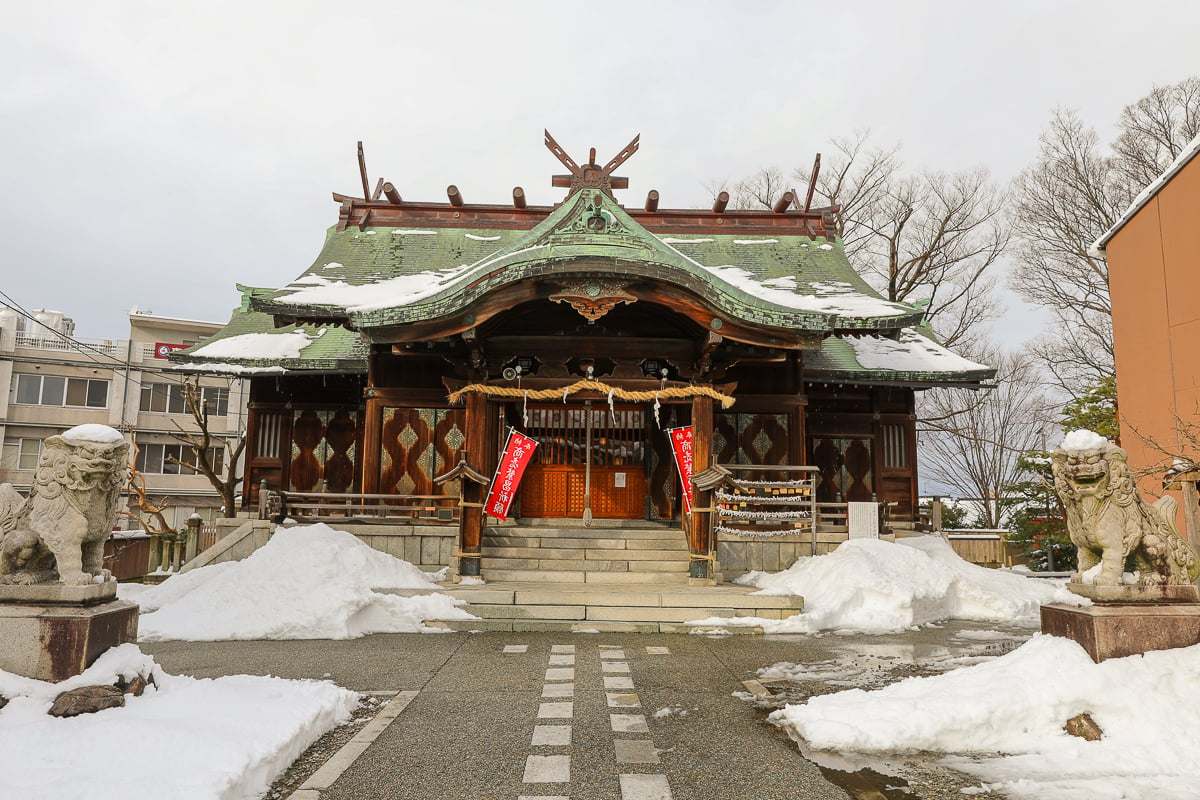
FAQs About Traveling to Kanazawa
You need two full days to explore Kanazawa’s highlights – Kenrokuen Garden, Kanazawa Castle, Omicho Market, and the geisha and samurai districts – without rushing. If you love food and art, stay three or four days to dive deeper into the best Kanazawa restaurants, visit the local art museums, or take a day trip to Shirakawa-go.
Absolutely! I’ve spent many months exploring Japan, and I think Kanazawa is one of Japan’s most authentic, culture-rich, and delicious cities. Known as “Little Kyoto,” Kanazawa is rich in history, craftsmanship, and cuisine, but with a fraction of the crowds you’ll find in Tokyo or Kyoto.
Part of Japan’s Hokuriku region, Kanazawa is a cultural and culinary hub known for its perfectly preserved samurai and geisha districts, Kenrokuen Garden, Kanazawa Castle, and gold leaf crafts. It’s also celebrated for its exceptional seafood from the Sea of Japan – especially snow crab!
From Tokyo Station, take the Hokuriku Shinkansen directly to Kanazawa Station. The ride takes 2.5 to 3 hours and is covered by the Japan Rail Pass.
Yes – Kanazawa is about two hours from Kyoto by the Limited Express Thunderbird train, making it an easy addition to your Japan itinerary, after spending two days in Kyoto.
Yes, Kanazawa is flat and easy to explore on foot. Most major attractions – including Omicho Market, Kanazawa Castle, and the geisha districts – are within a 30-minute stroll of each other.
